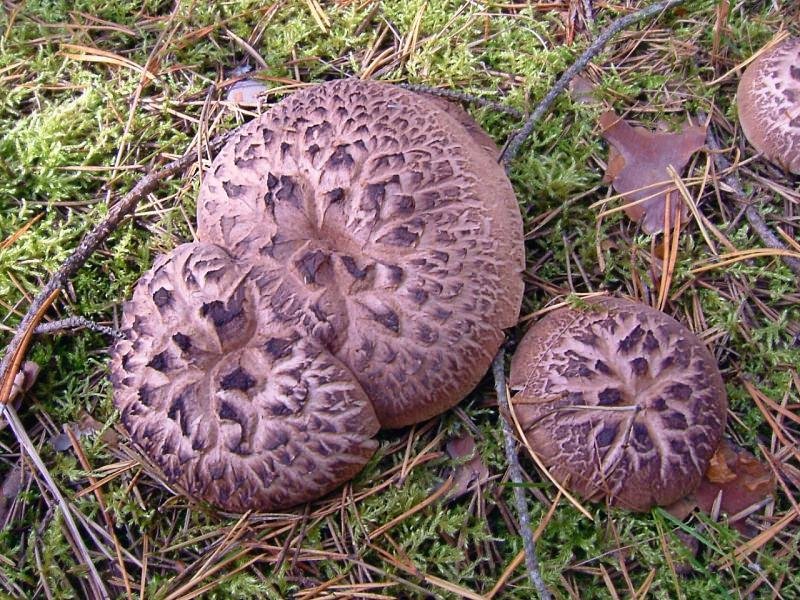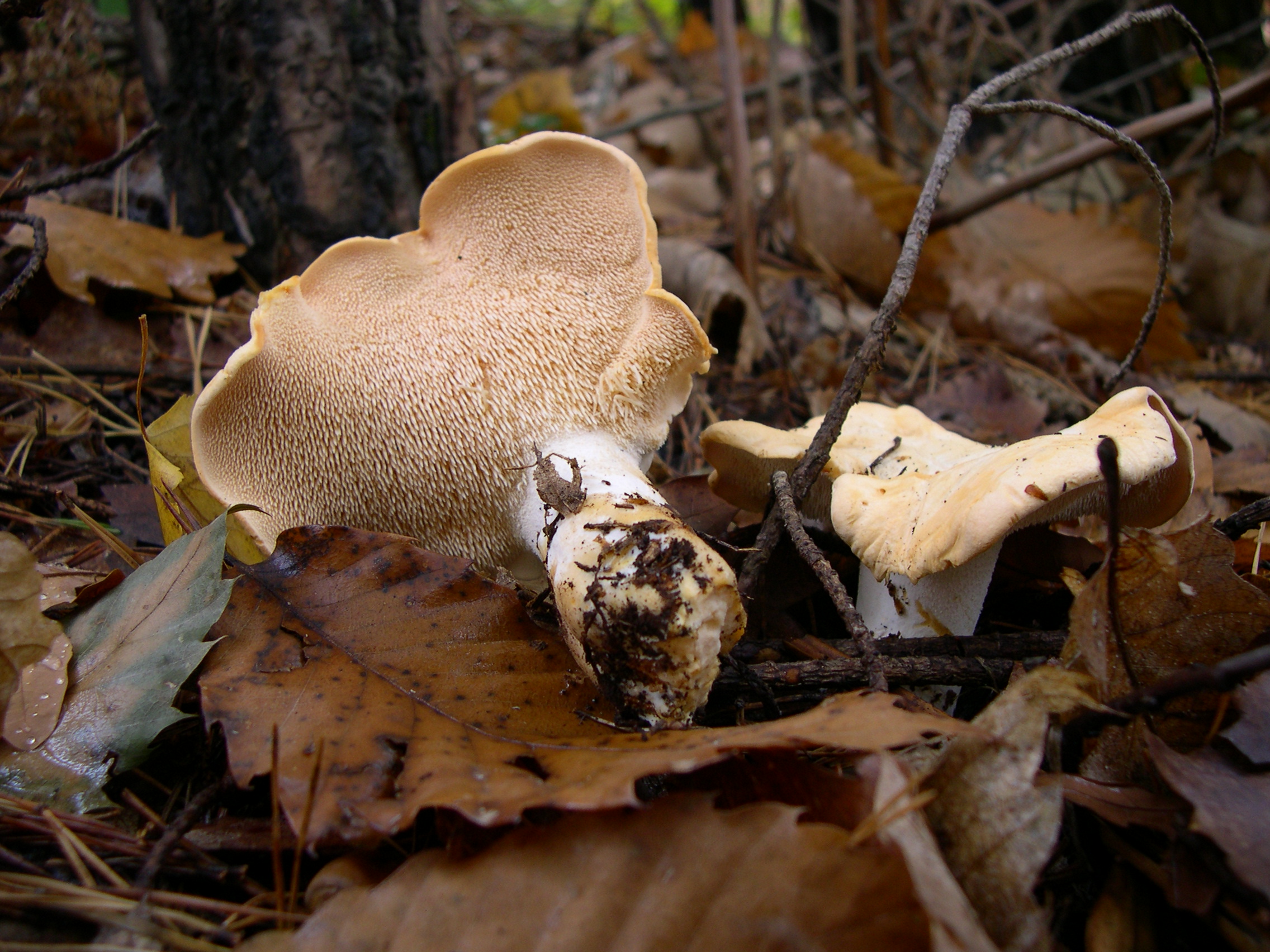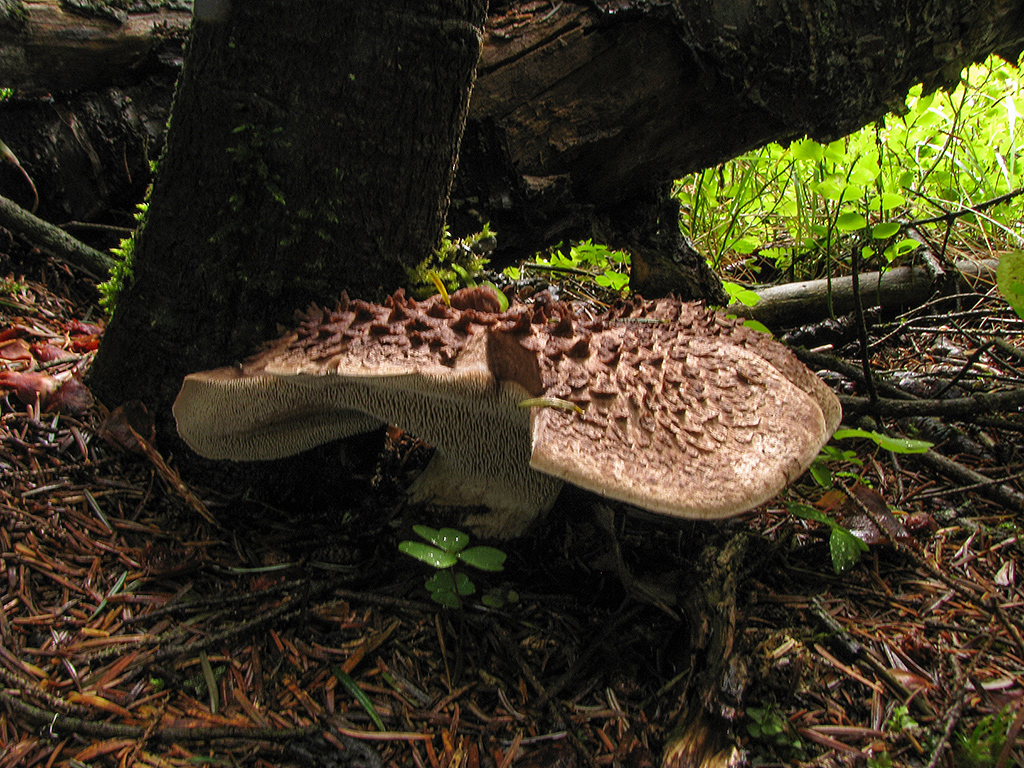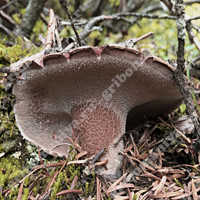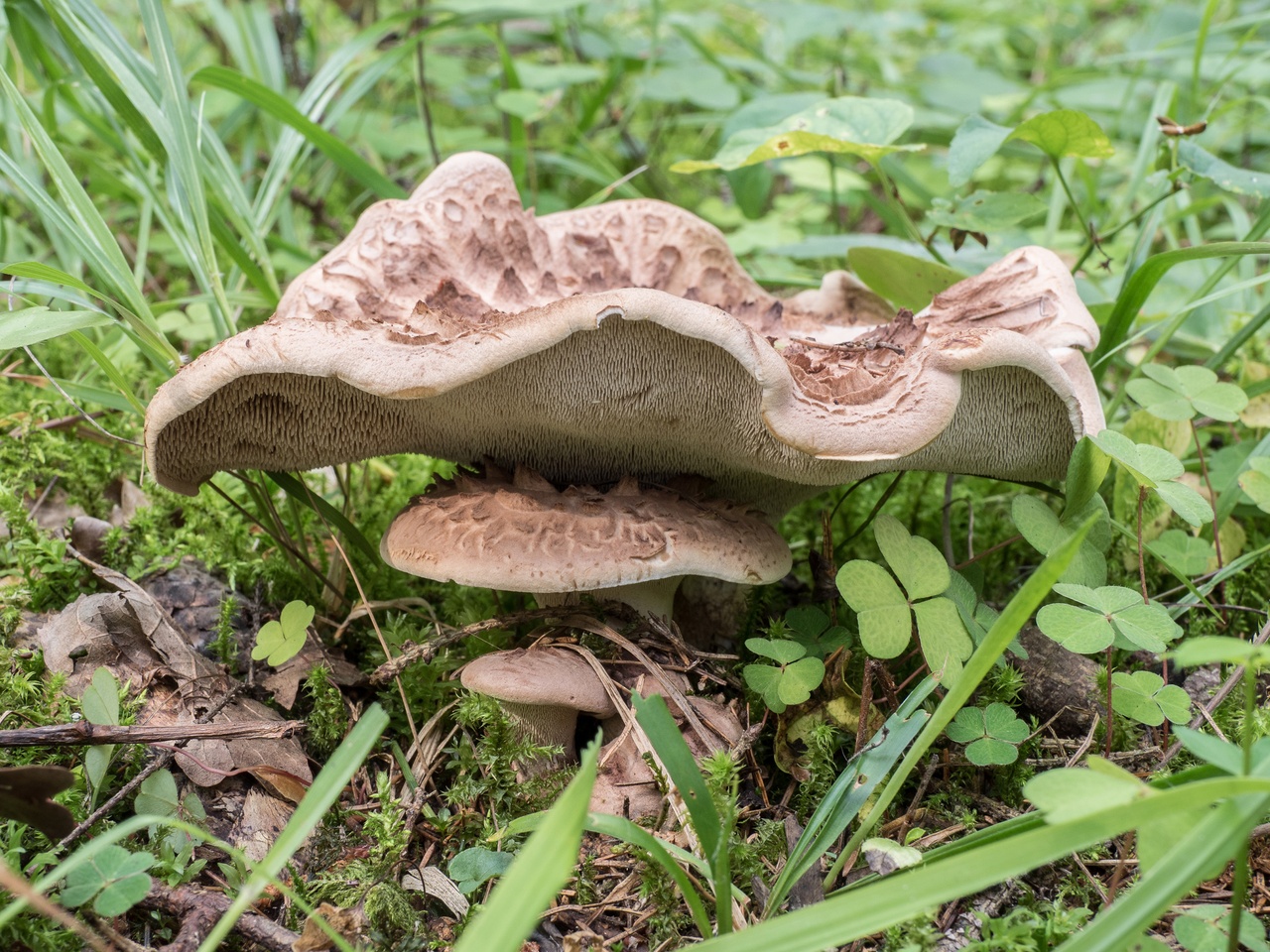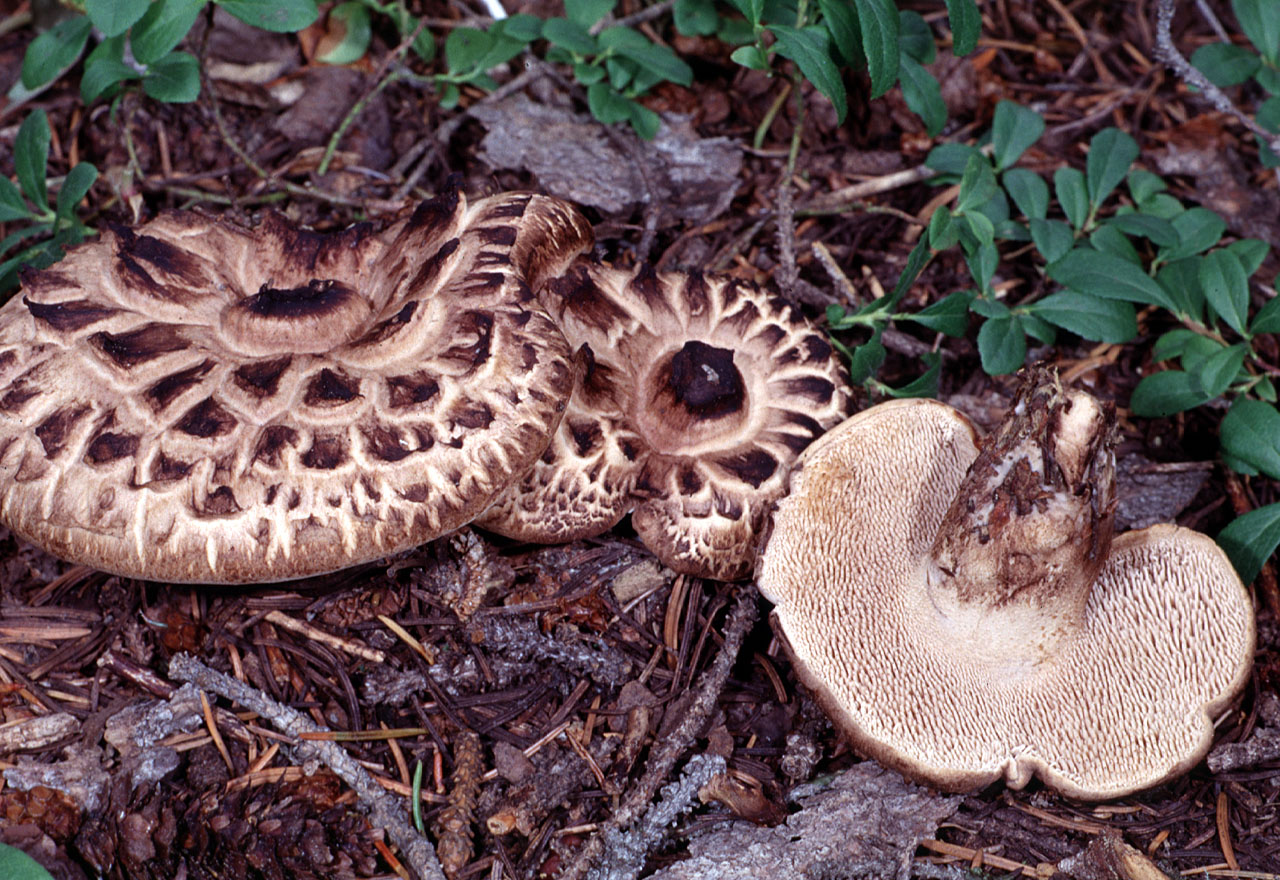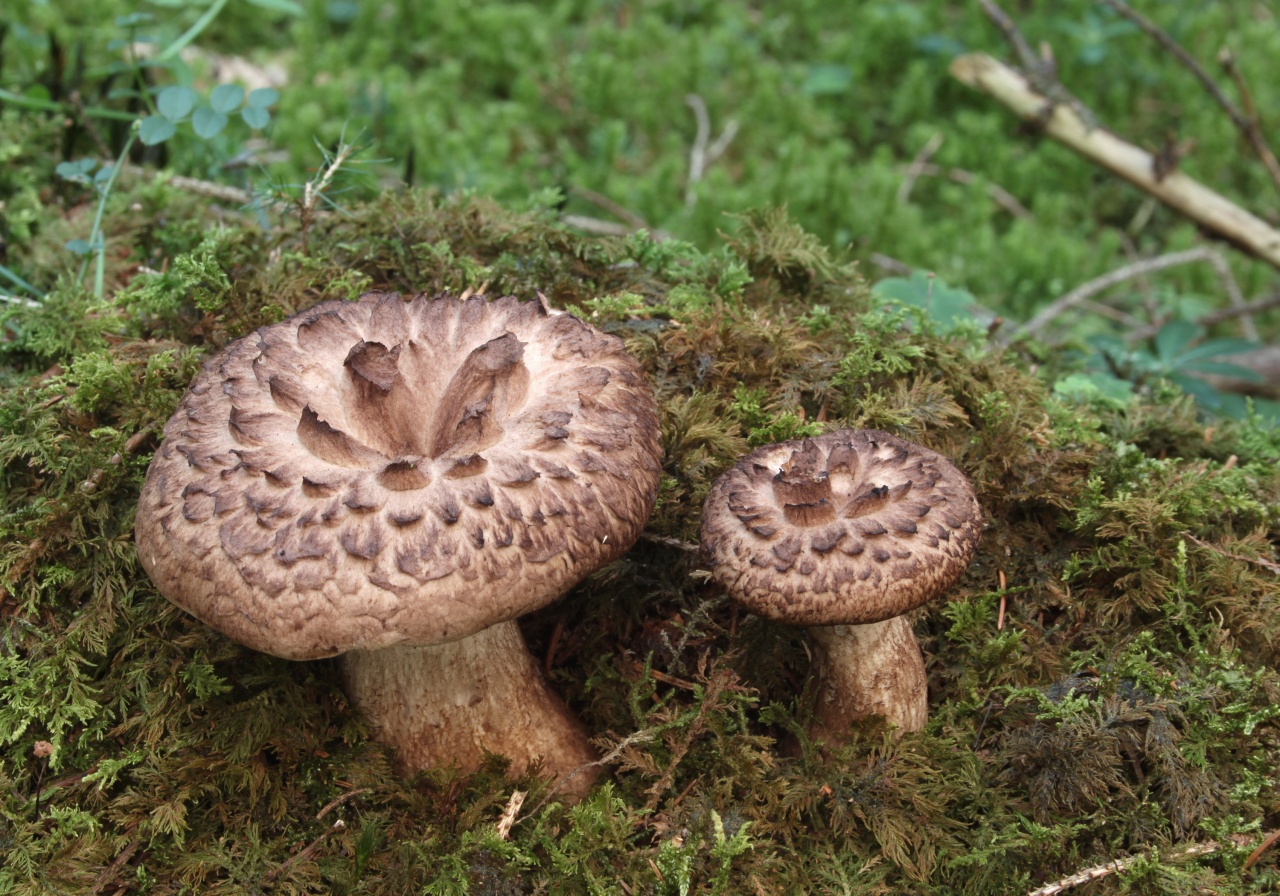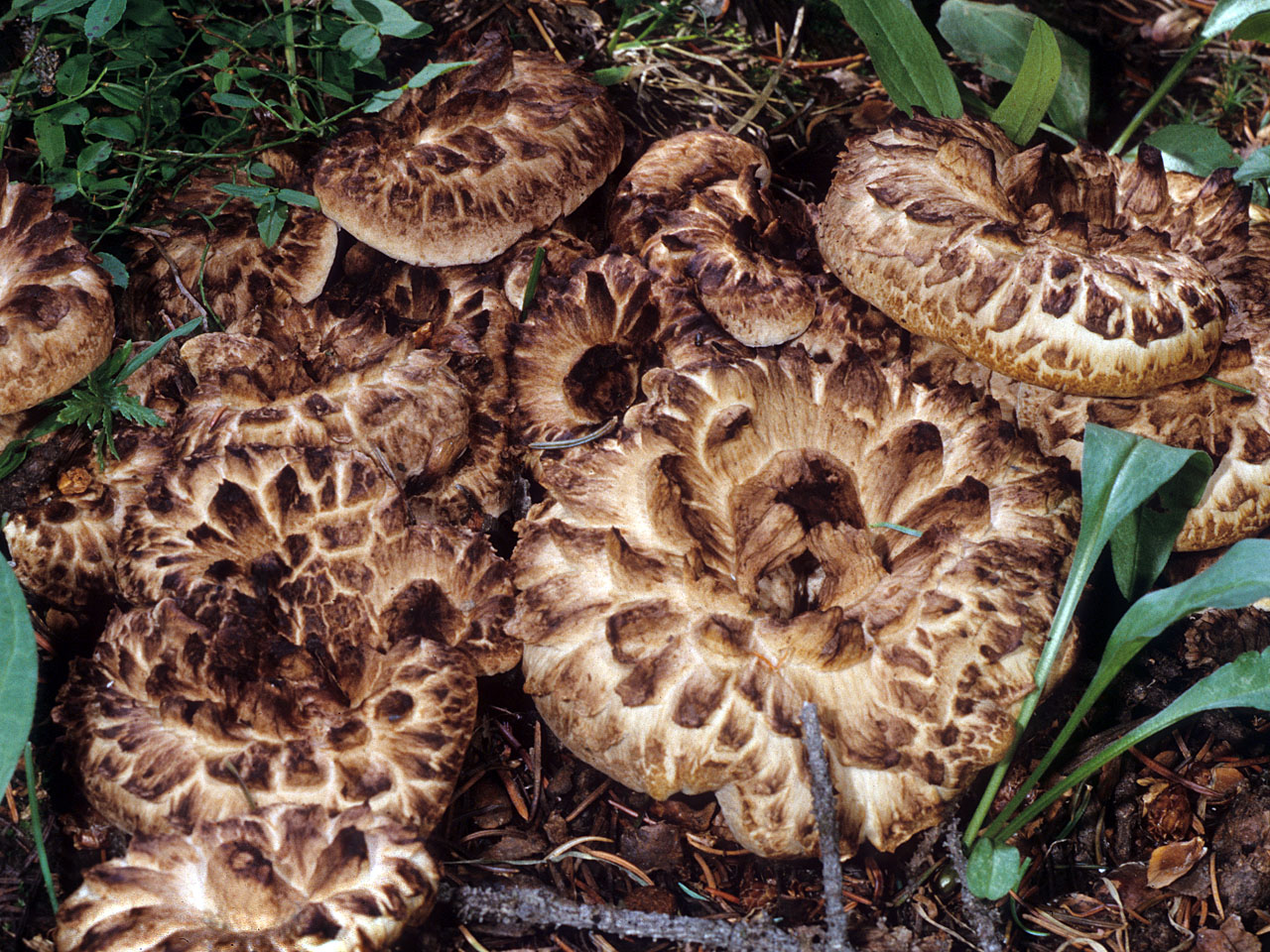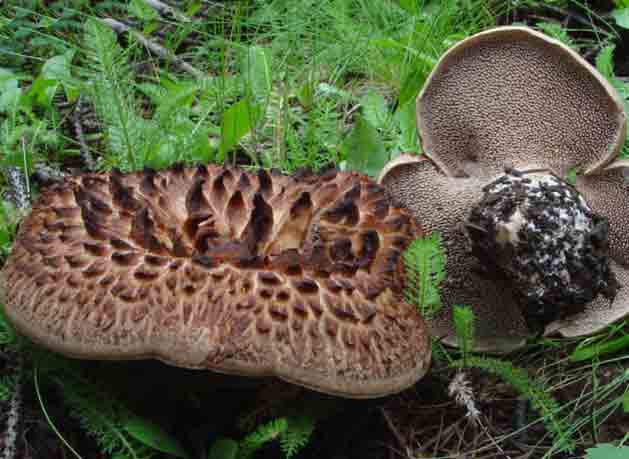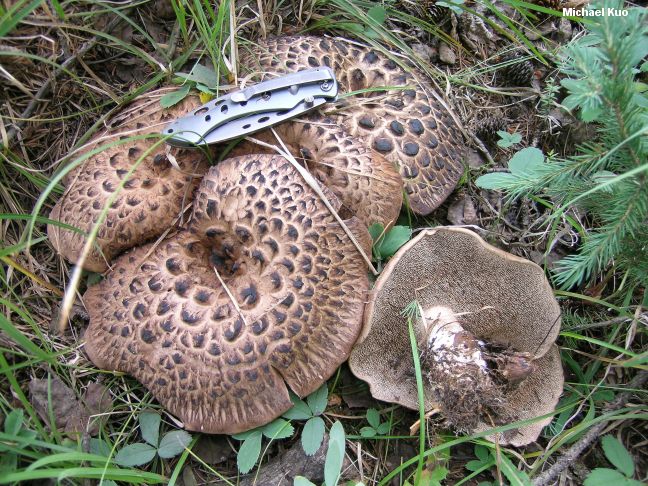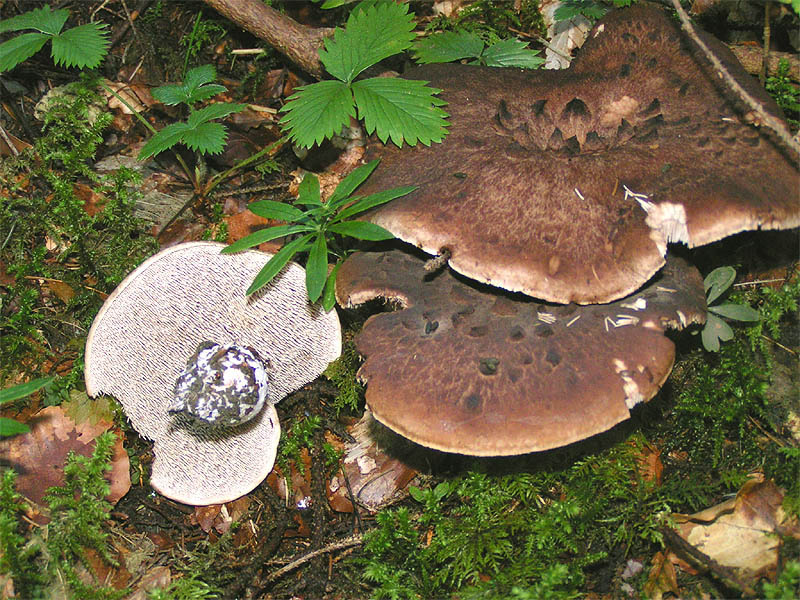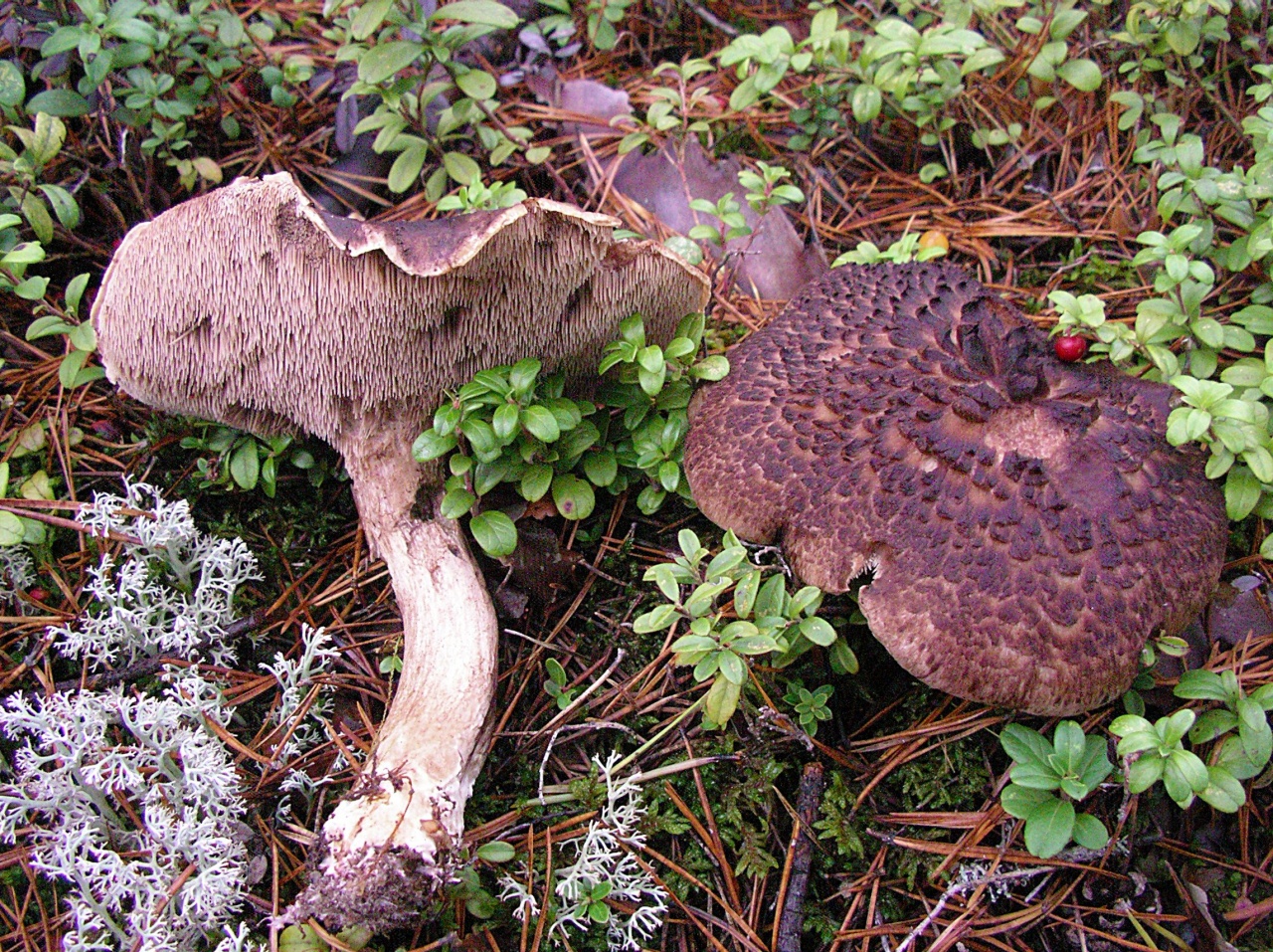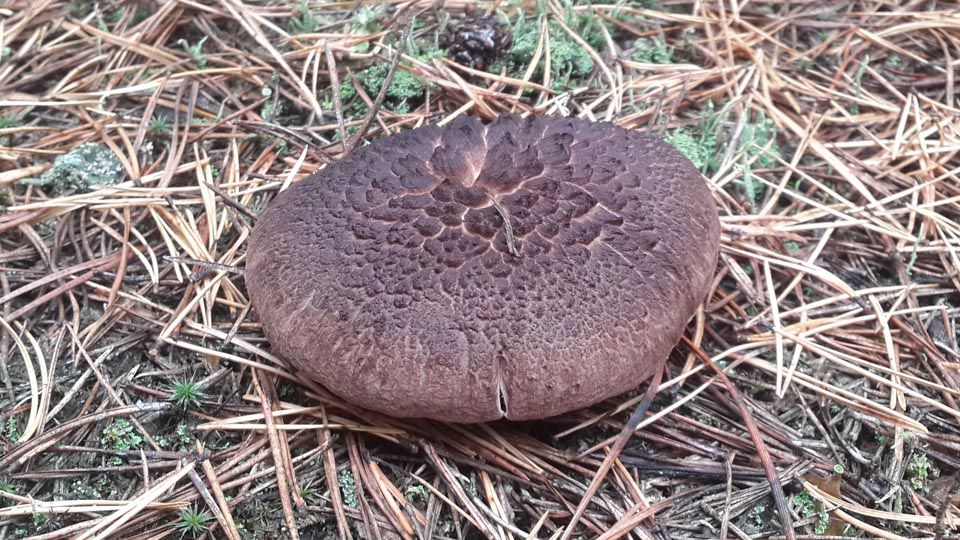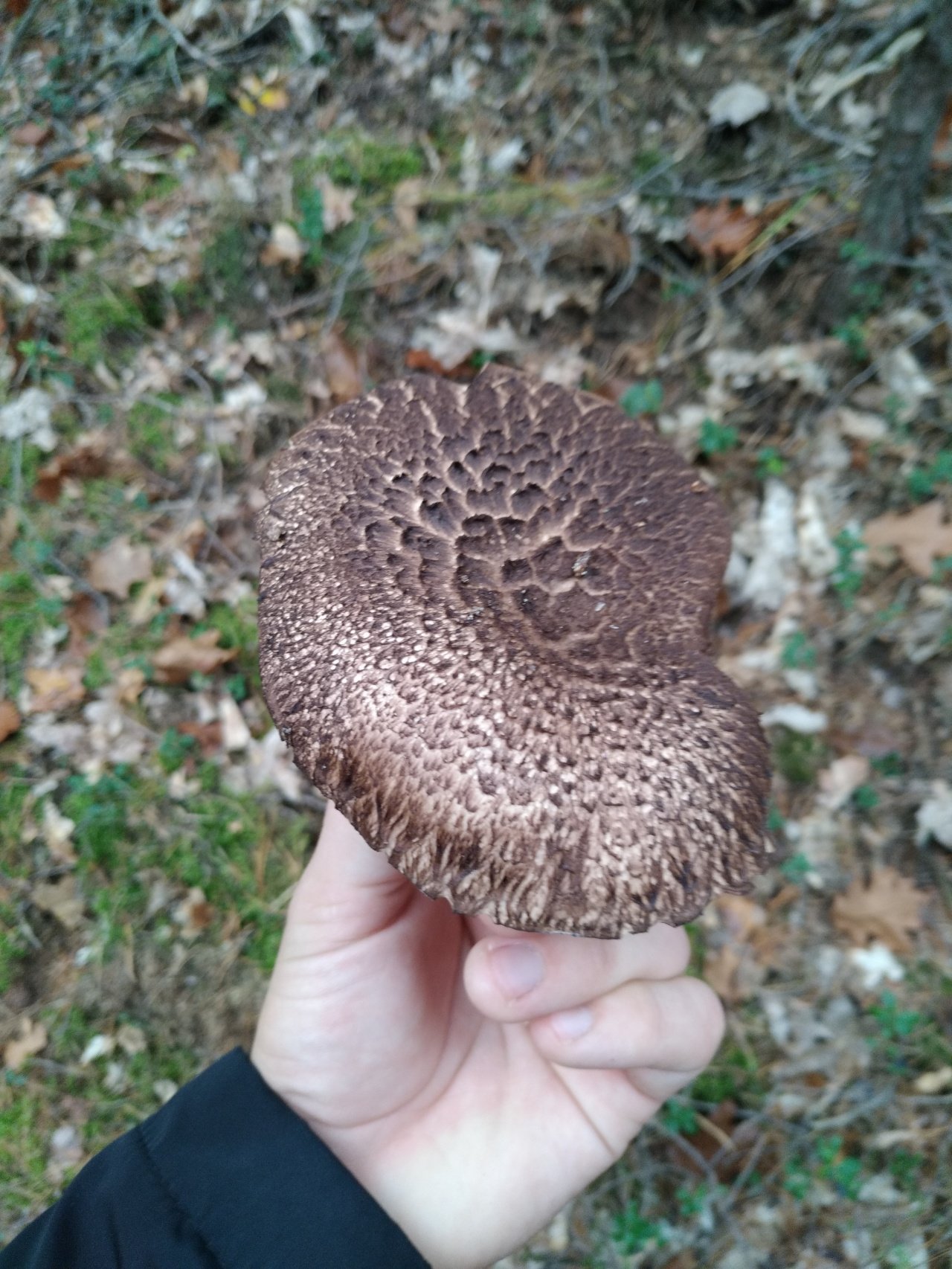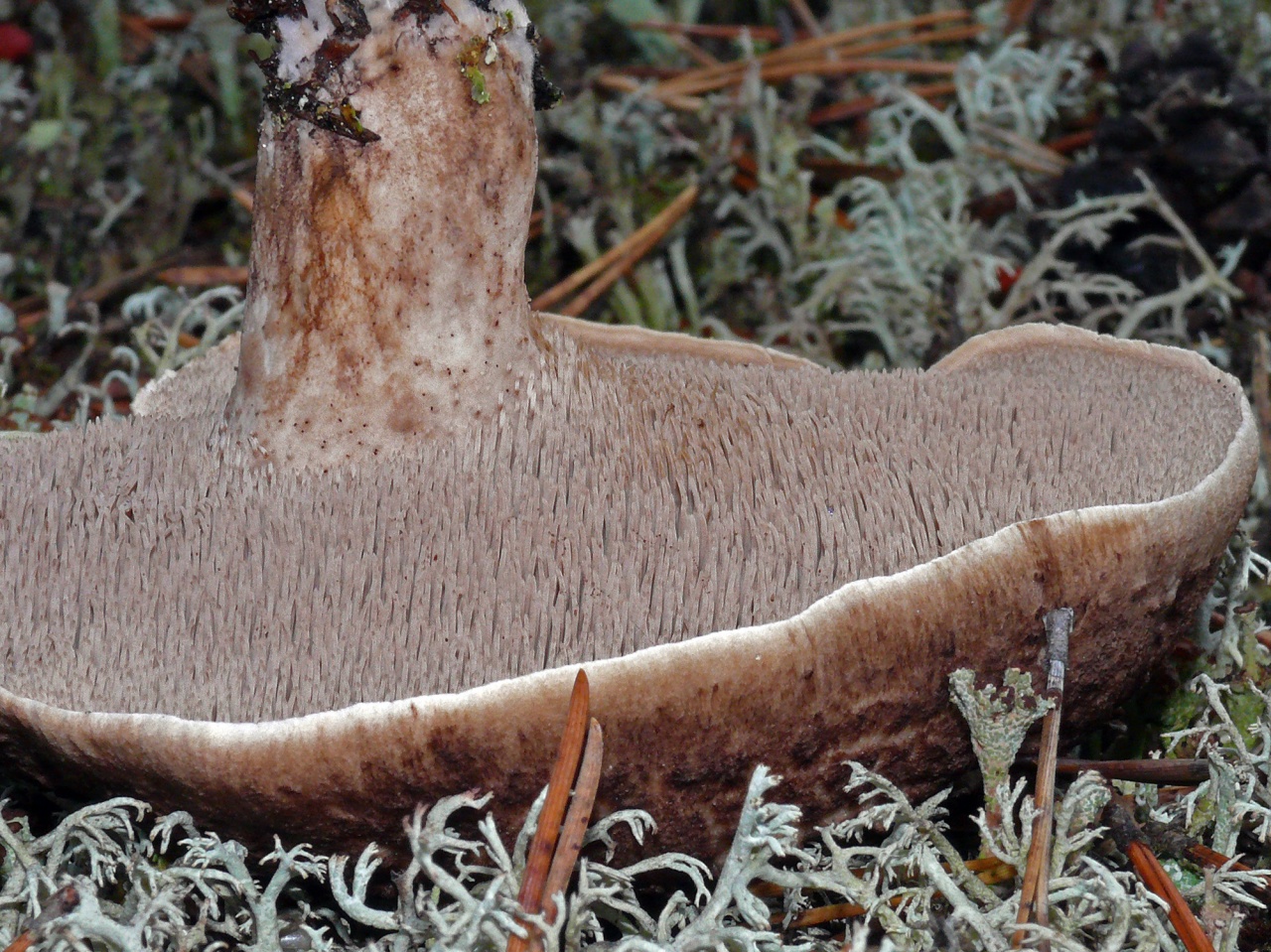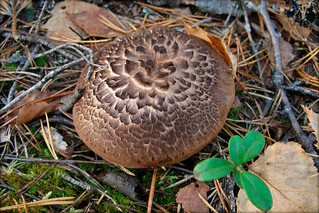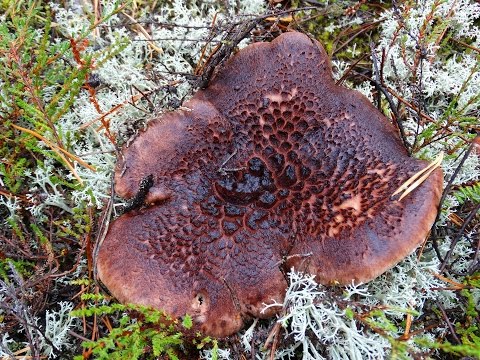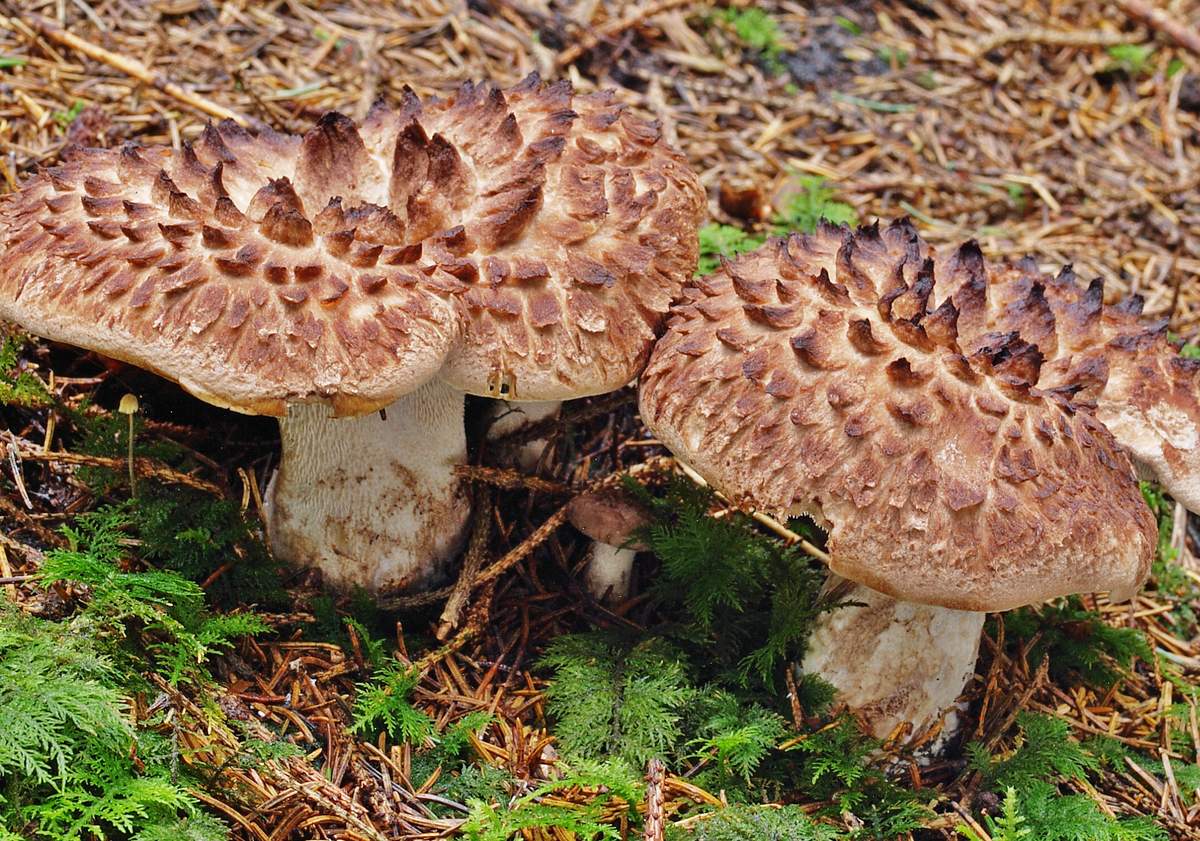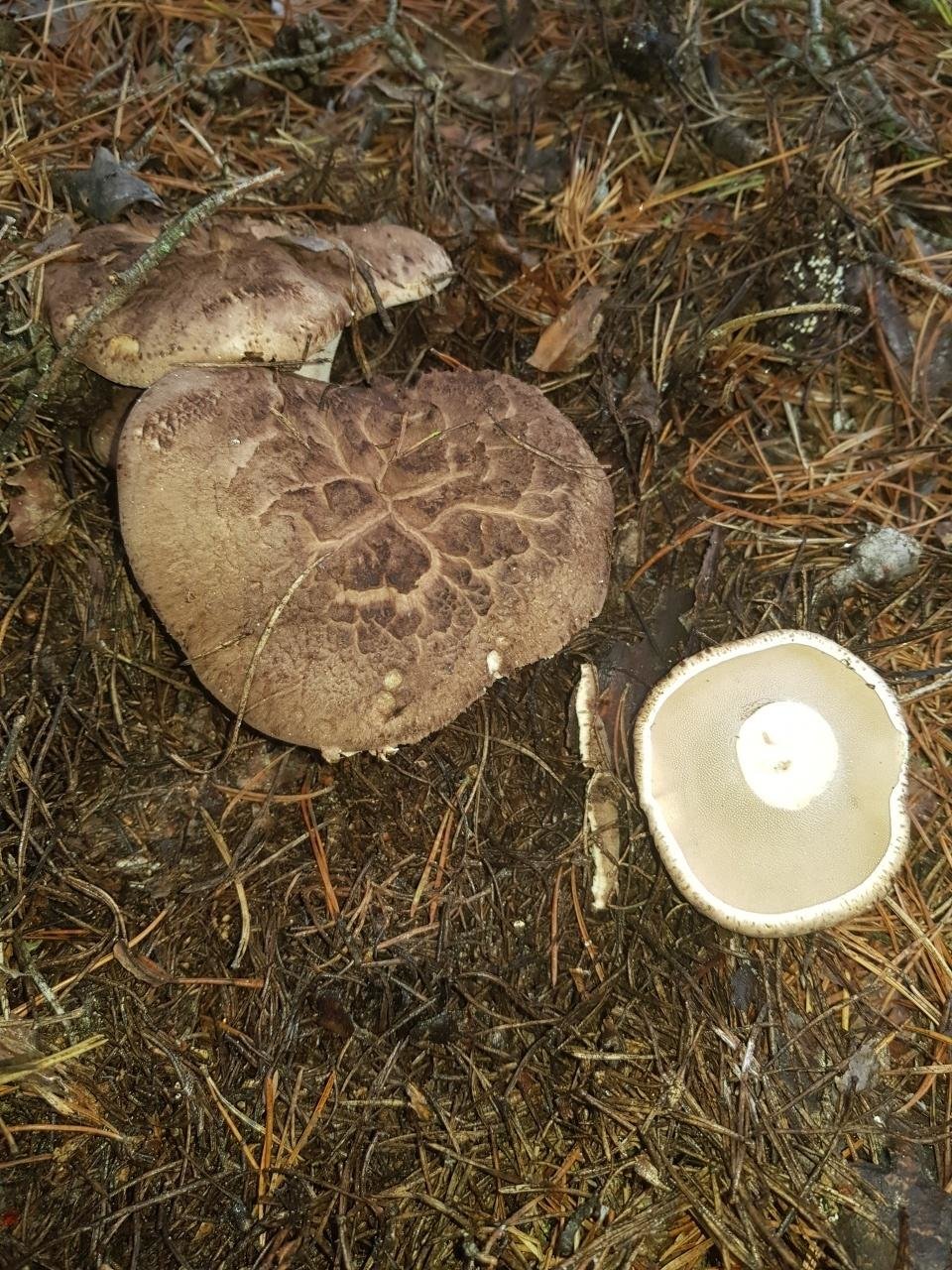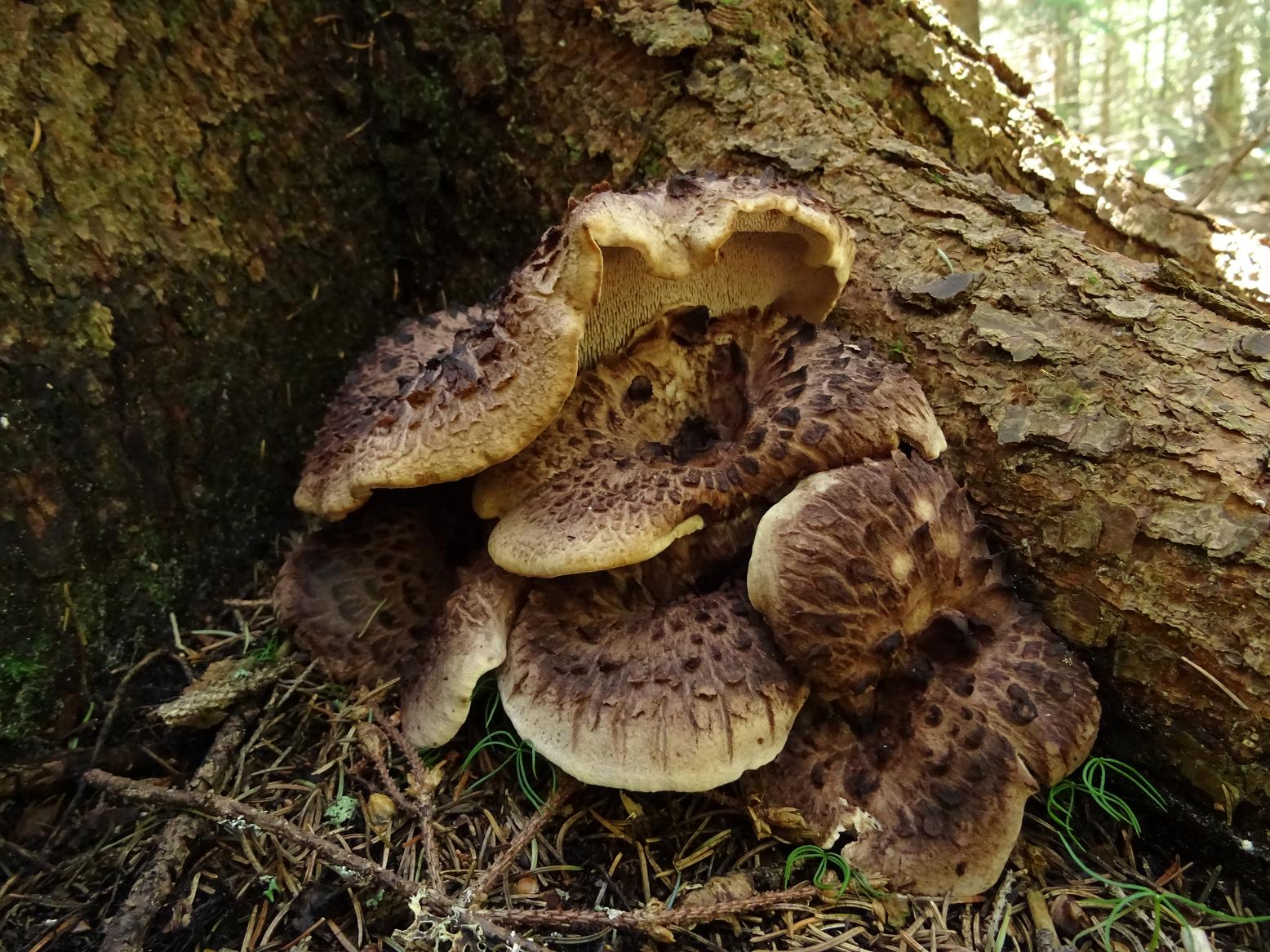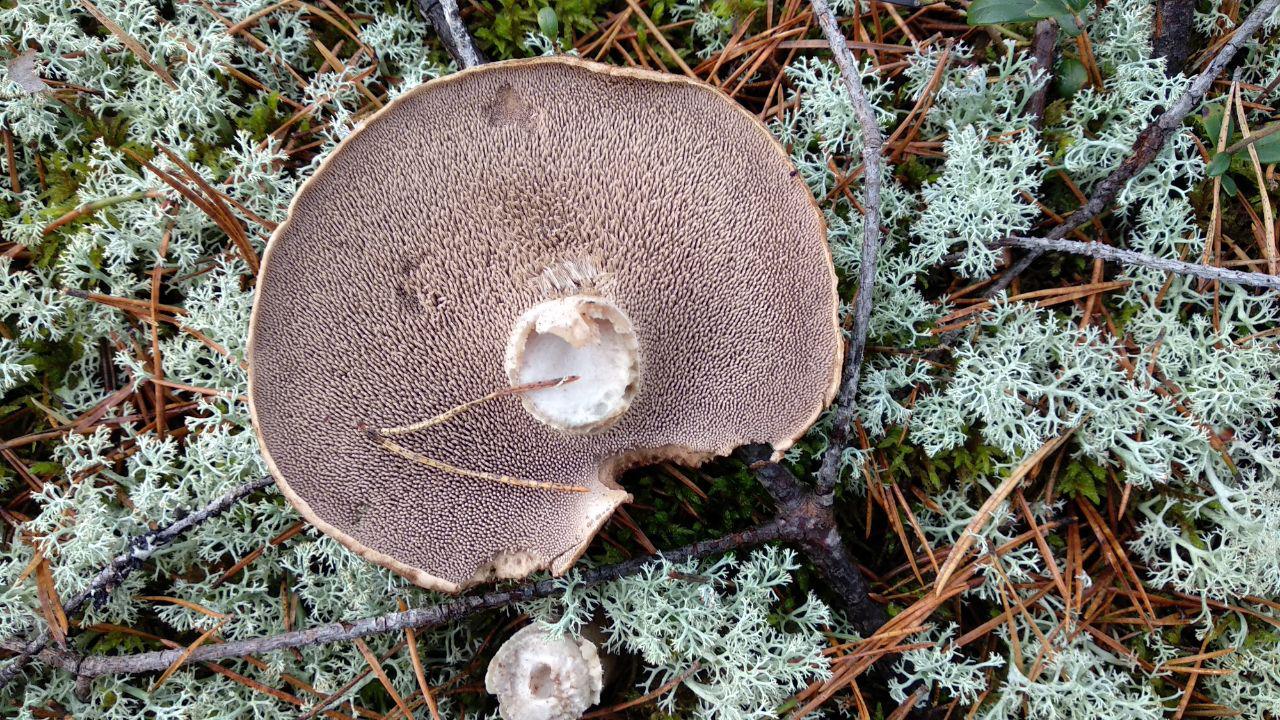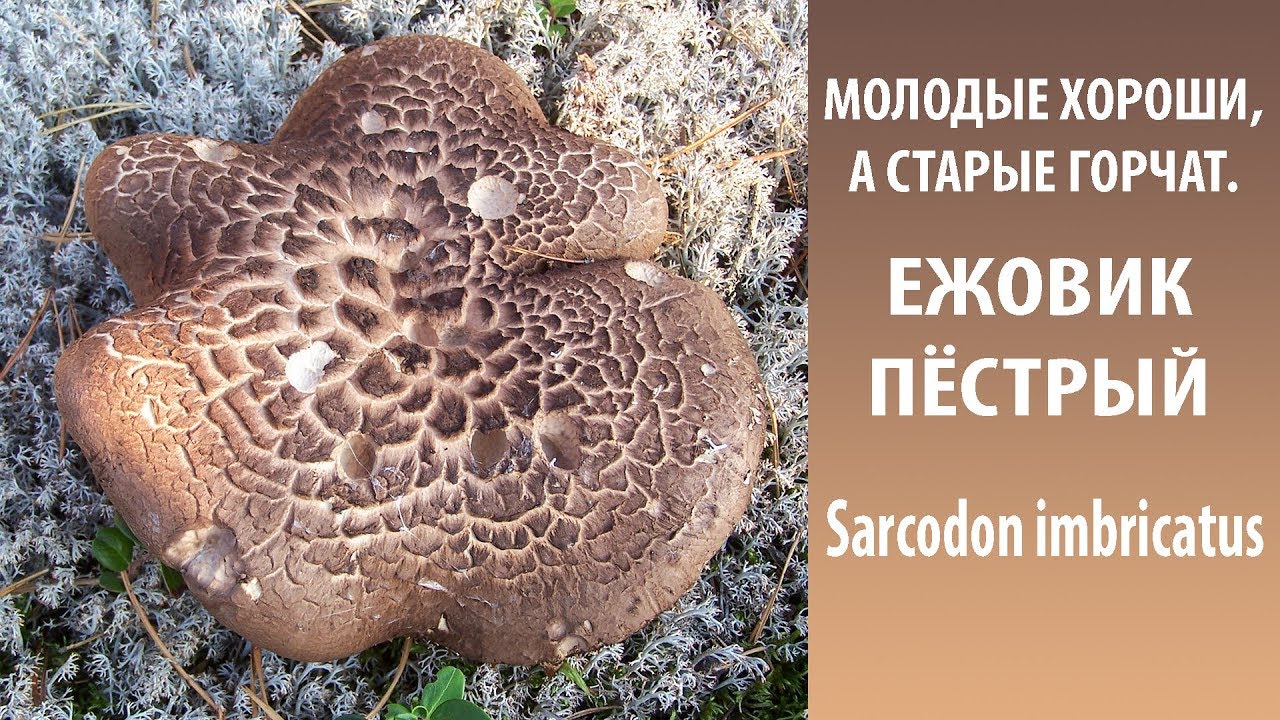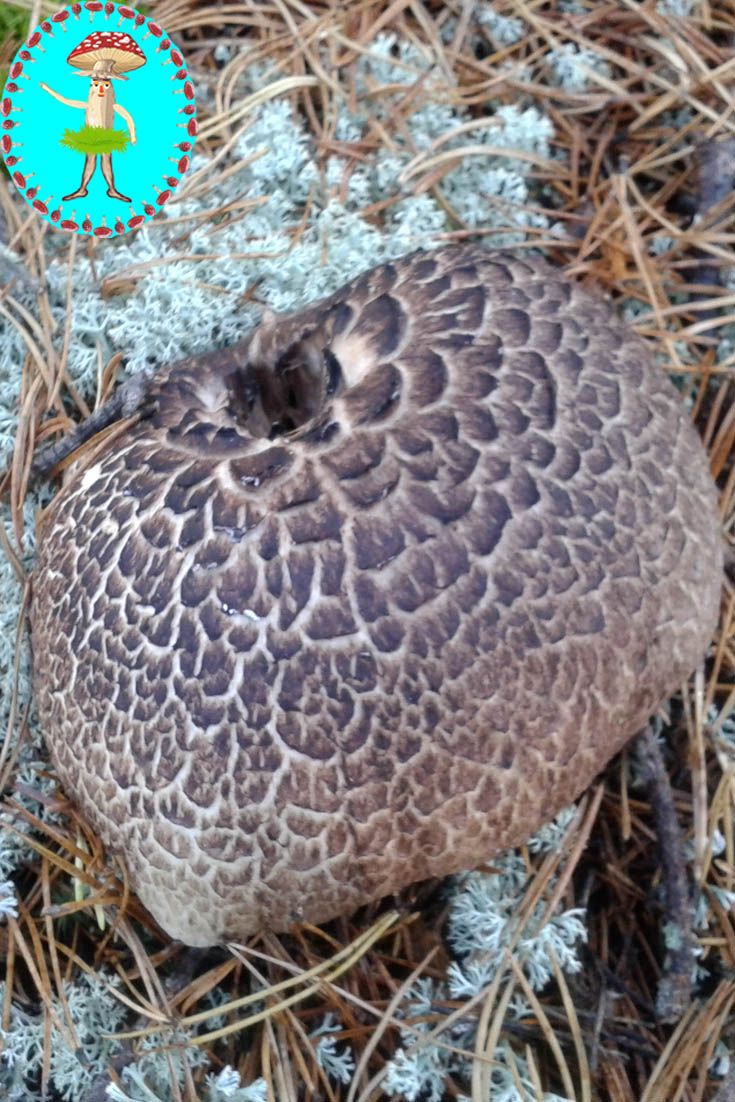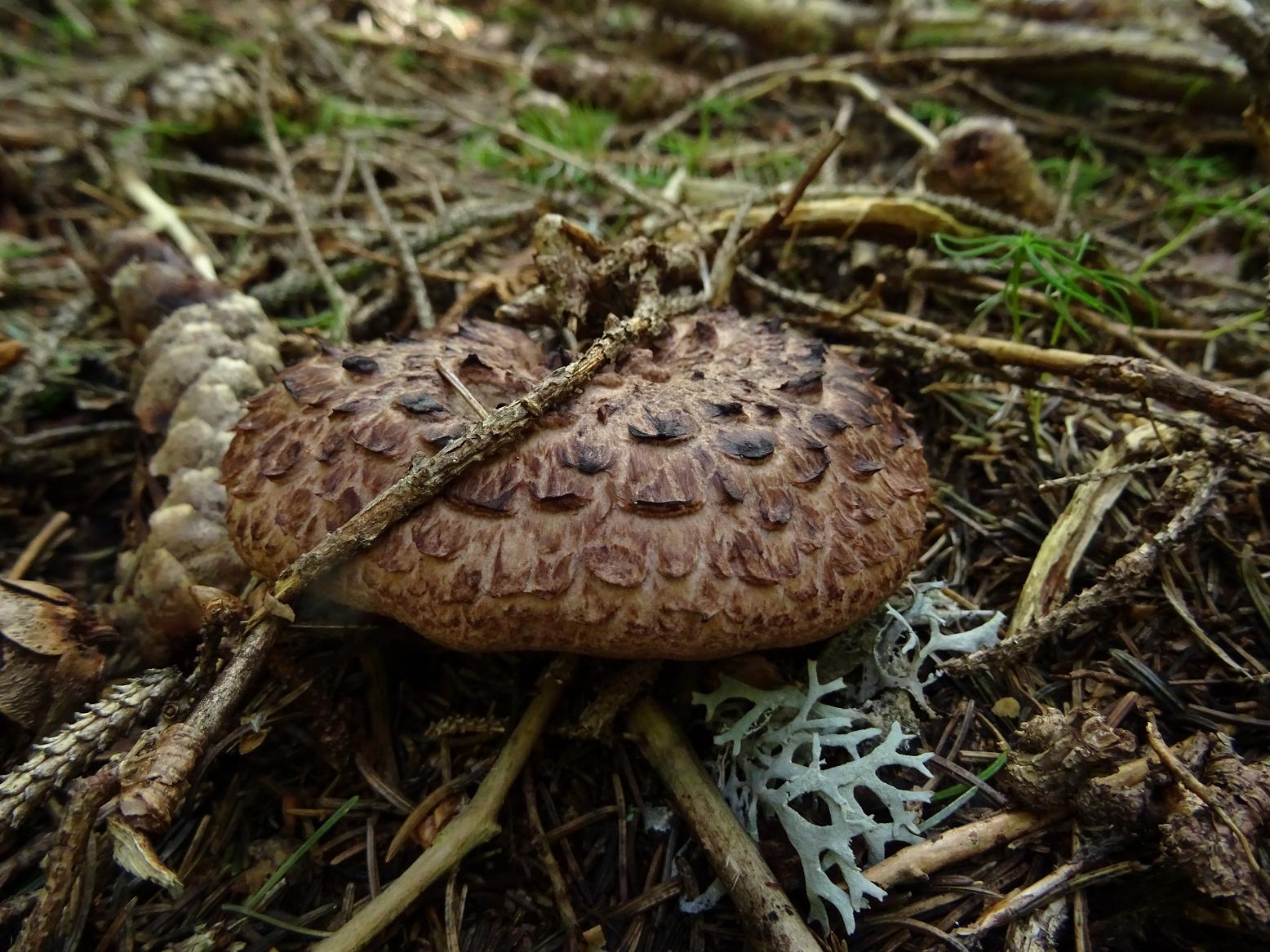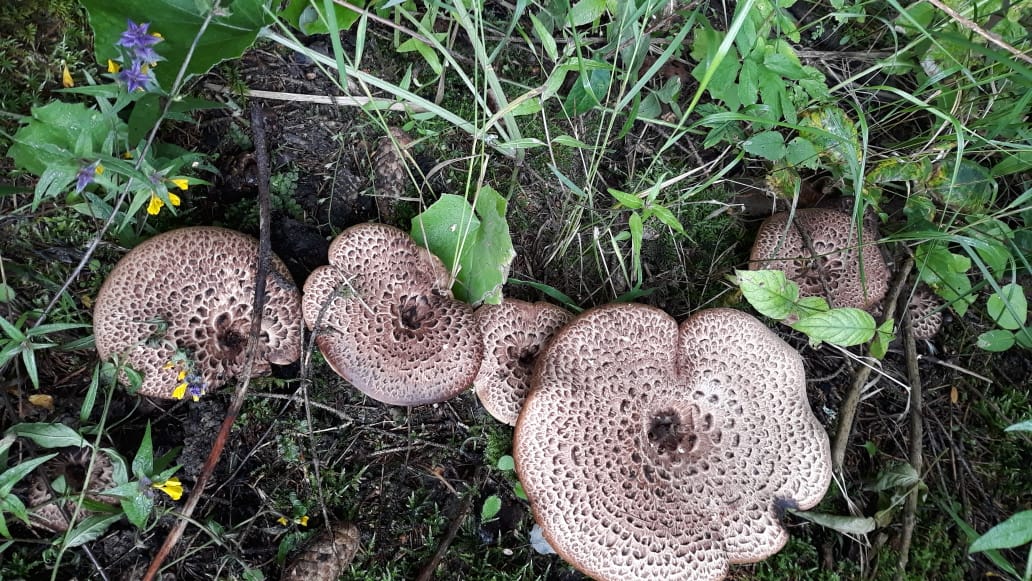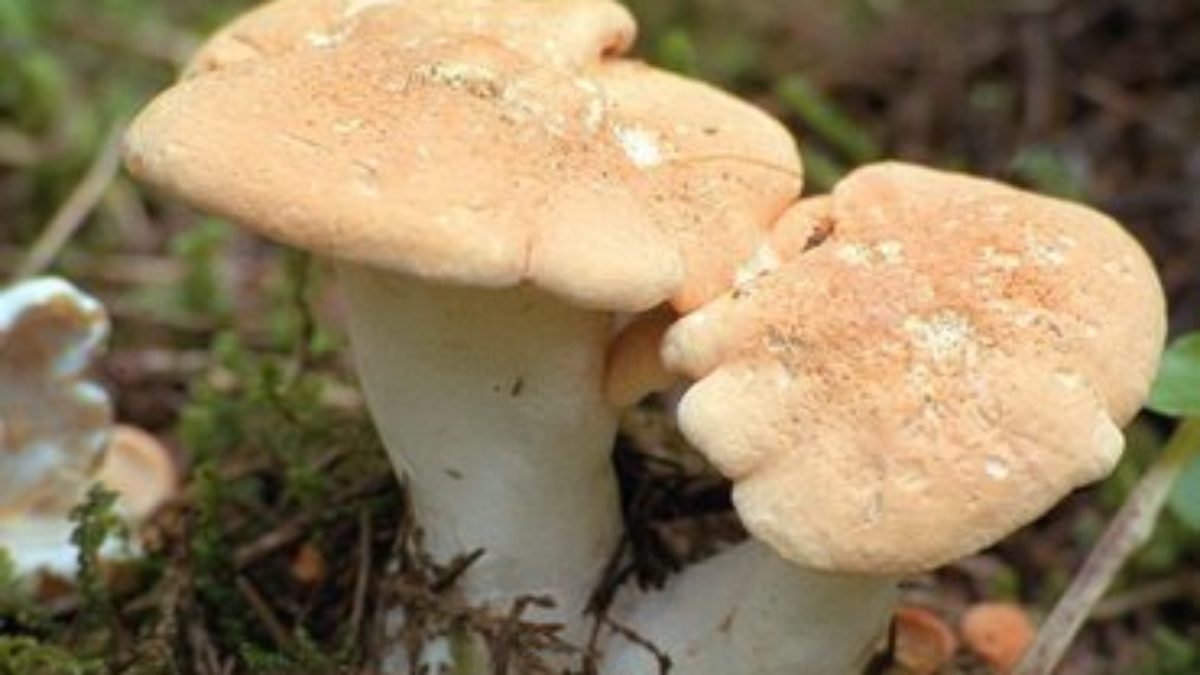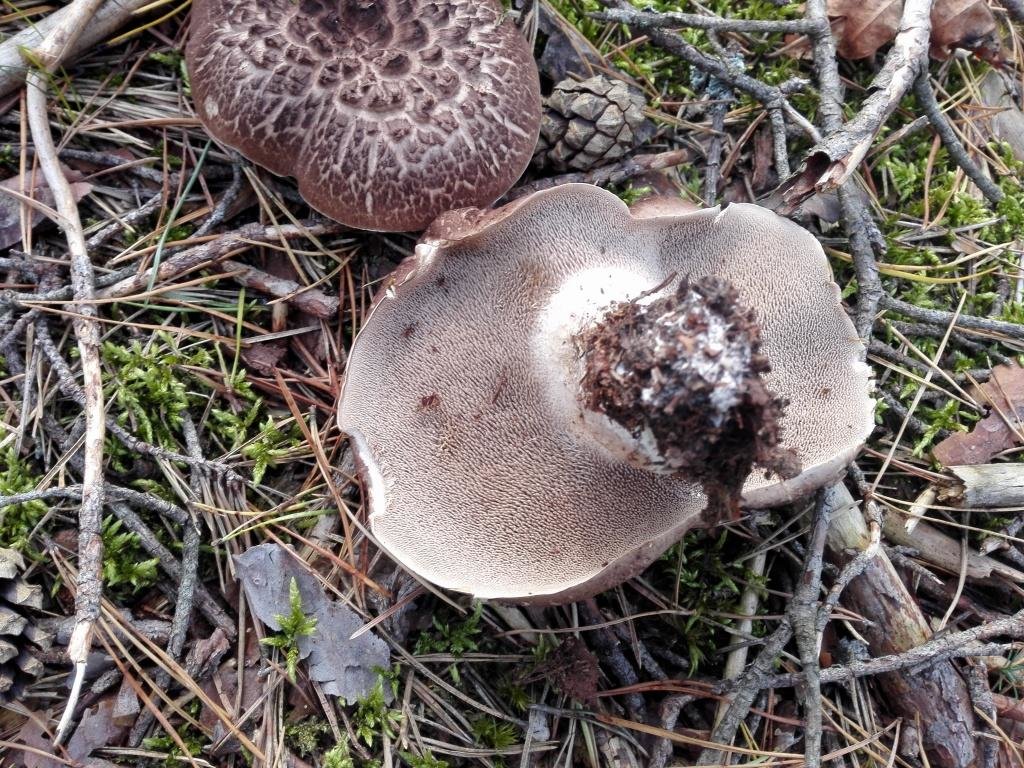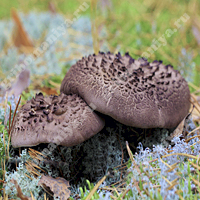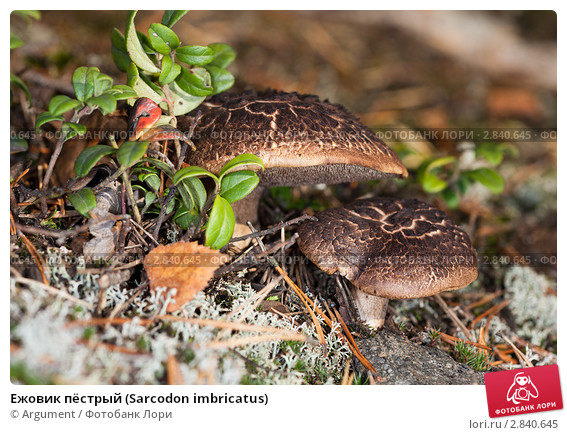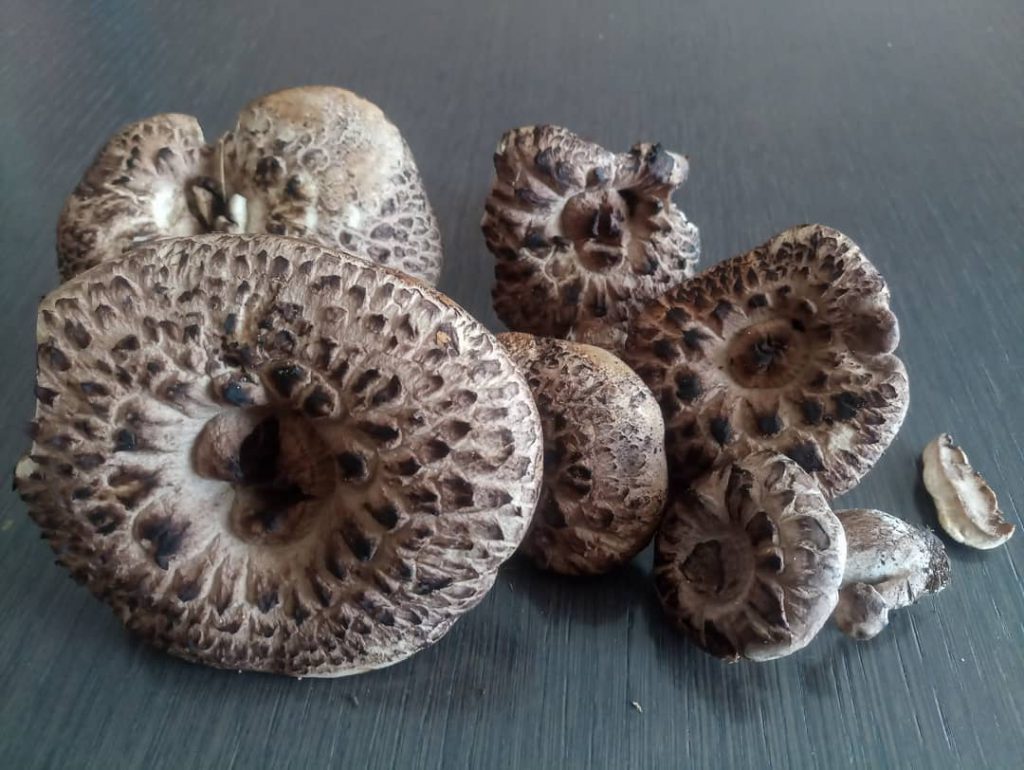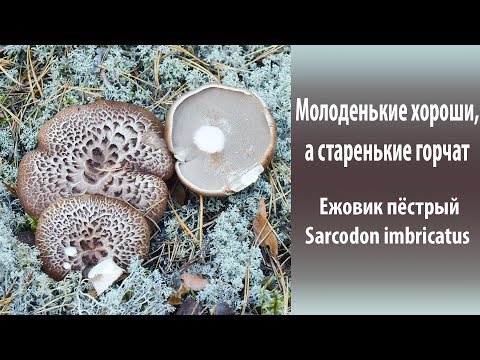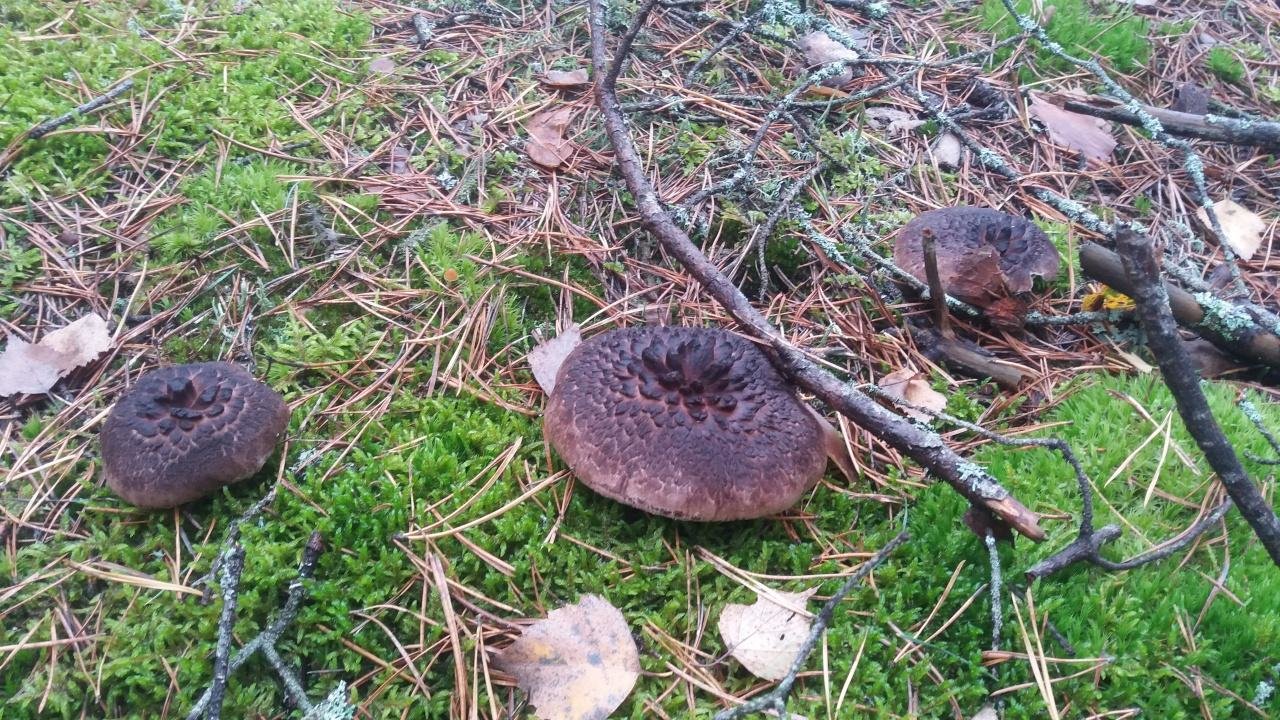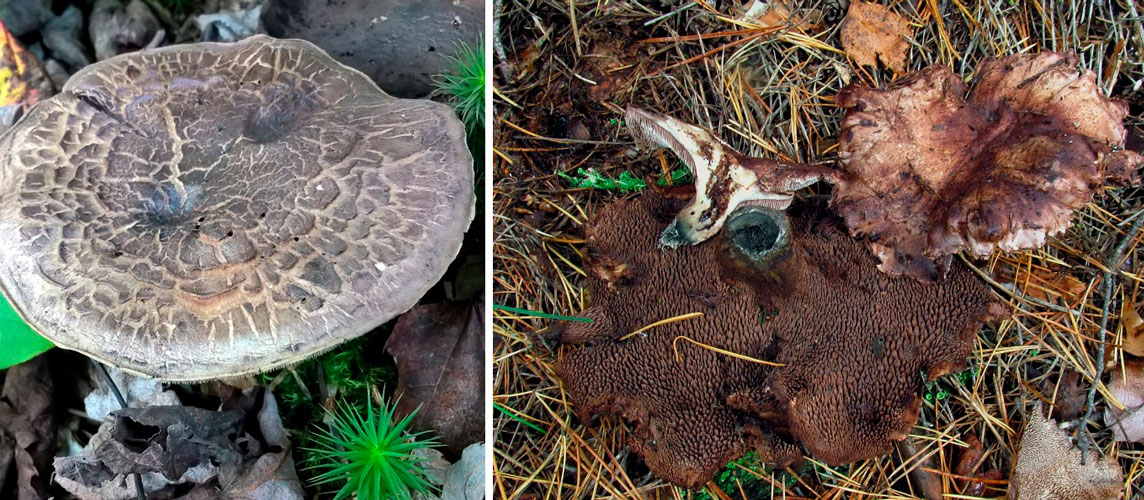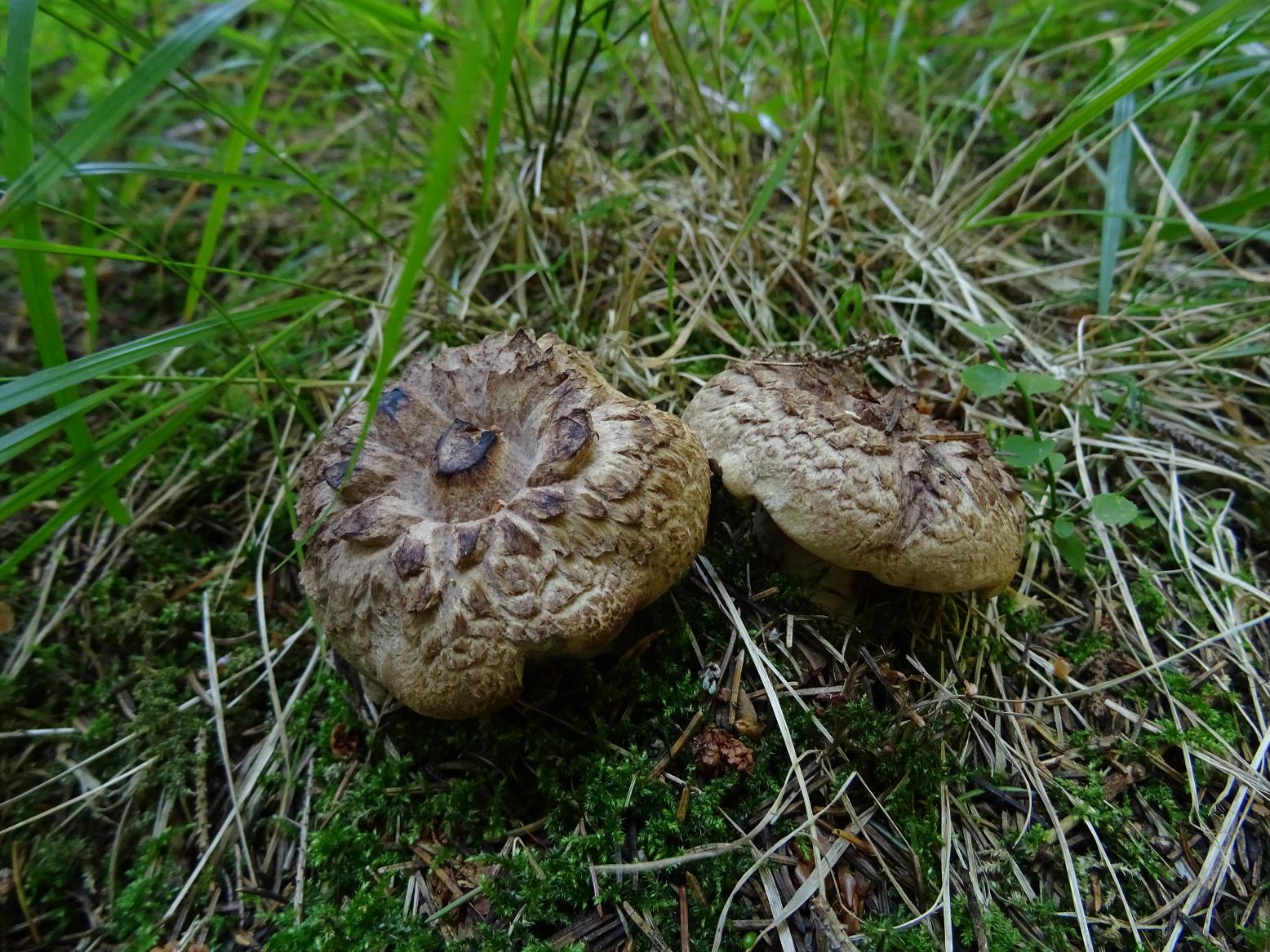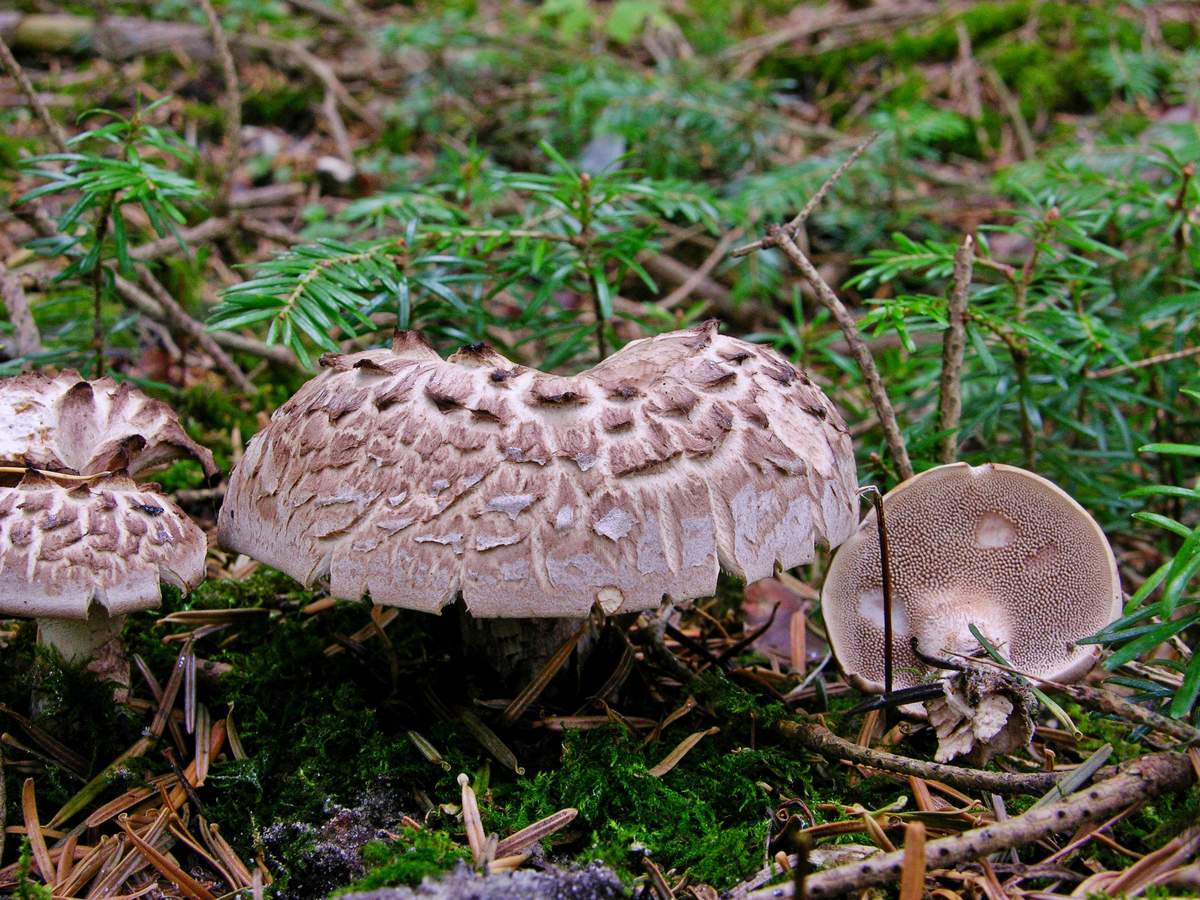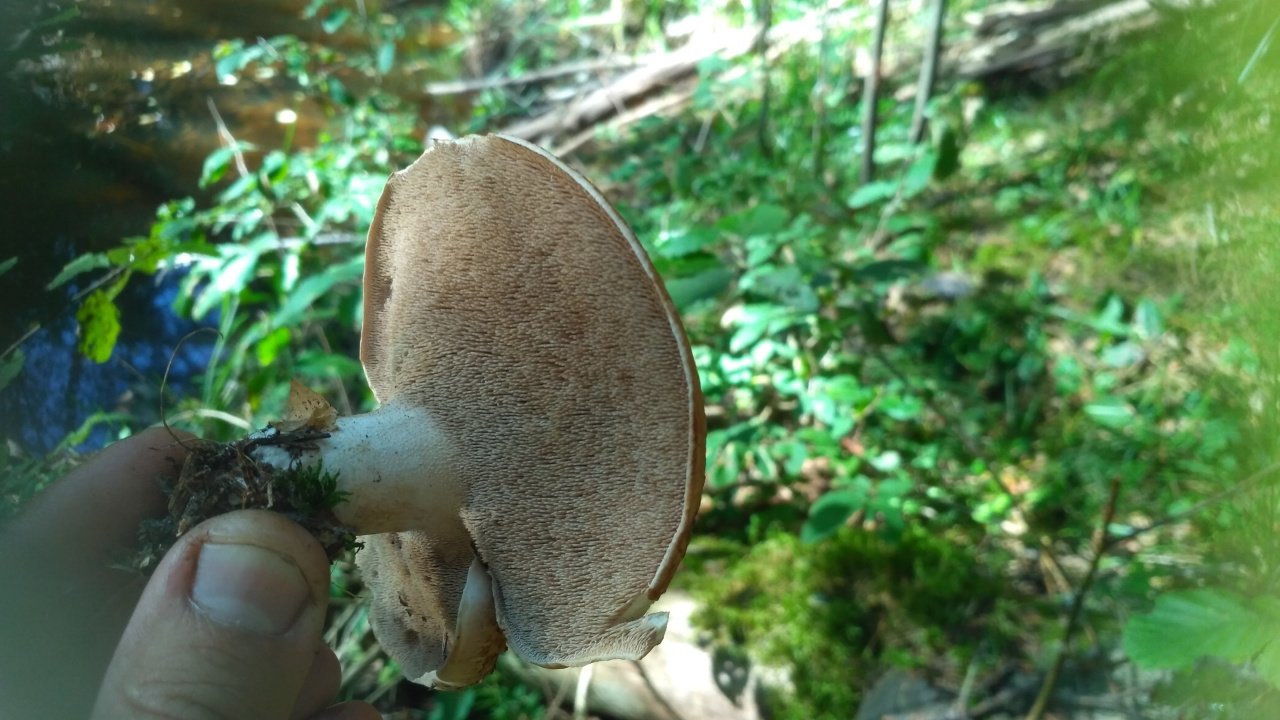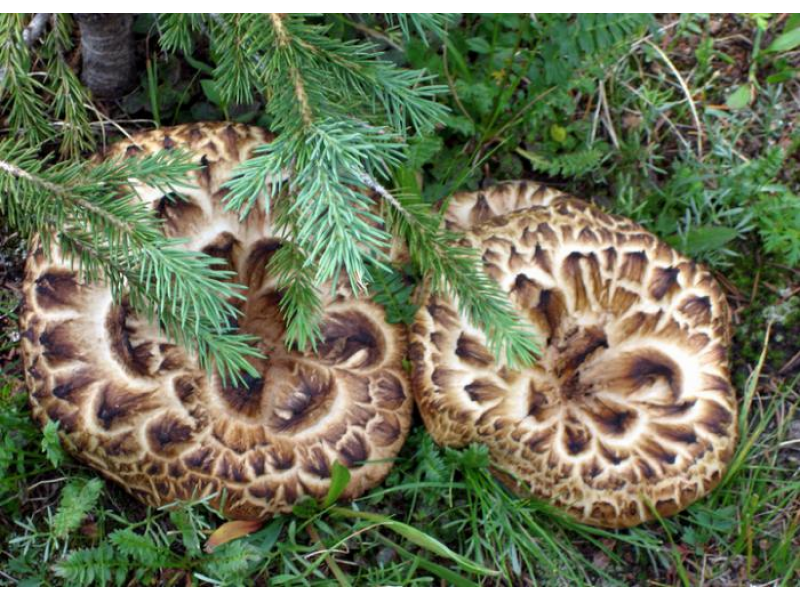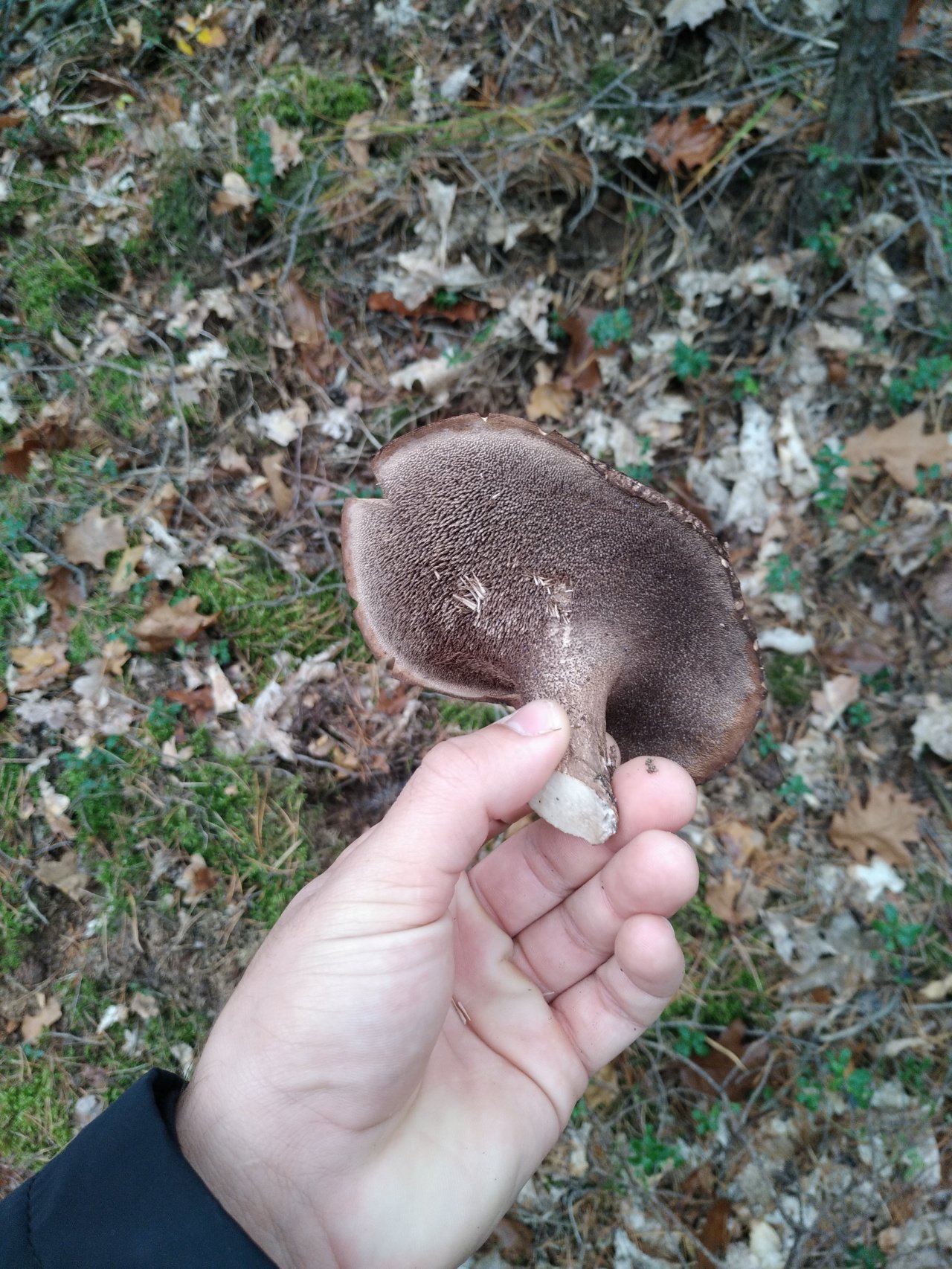Types of blackberry mushrooms
Blackberries originally belonged to the Gidnum genus. Subsequently, scientists, having identified differences between the species, divided the genus into families. Most of them are quite rare, and some of them are included in the Red Book.
Blackberry variegated (tiled)
Conditionally edible mushroom of the sarcodone genus, which is popularly called Kolchak or hawk. The variegated mushroom was nicknamed because of its variegated color and large convex scales on the cap, similar to tiles.
The brown cap grows to a considerable size, reaching a diameter of 20 cm. In the central part it has a depression in the form of a funnel. In young individuals, the edge of the cap is wrapped. At the bottom there are brittle spines, descending to a massive leg, which is painted in lighter colors than the cap. The inside is whitish and dense. Prefers to settle in coniferous forests.
Blackberry yellow
The fleshy cap with a diameter of 6 to 12 cm has a flat shape and a concave center. Depending on the region of growth, the color changes from white to orange. Smooth to the touch with a hard-to-peel film. On the lower part, yellow fragile thorns grow, descending to the stem.
Often there are specimens with a leg attached off the center. The pulp is dense and whitish in color. The height of the cylindrical leg is up to 6 cm. In the lower part it is slightly widened. In the process of growth, parts of the fruiting body can grow together.
Coral blackberry
This unusual-shaped mushroom turns the forest into a mysterious and magical one. But since he is listed in the Red Book, the likelihood of meeting him is very small. Usually the fungus settles singly on stumps and trunks of fallen deciduous trees.
The shape of the branched fruit resembles an underwater coral, reaching 20 centimeters in size. Smooth or curved spines, growing up to 2 cm, are white or cream colored.
The structure of the fruiting body is elastic-fibrous, white with a pleasant smell and taste. In mature individuals it becomes harsh.
Blackberry comb
The appearance of the fruiting body resembles noodles, which gave it synonymous names: bearded mushroom, mushroom noodles and lion's mane. Occurs on living and dead hardwood. The shape of the mushroom is round or irregular, reaching 20 cm. The weight of one body can be 1.5 kg.
When finished, it resembles seafood. The color ranges between cream and light beige. The fleshy pulp, when dried, turns from white to yellowish. In addition to good taste, it has medicinal properties.
Hunting and fishing in the Tver region
Hericium black, Phellodon niger
Hat: 3-8 cm in diameter, massive, usually irregular in shape, indistinctly turning into a leg. The fruit body of the fungus grows right through the forest “objects” (twigs, cones, needles), which ensures the uniqueness of each specimen. The color of young mushrooms is bright blue, with a light edge; as it grows, it turns gray and darkens, reaching almost black by maturity. The surface is generally dry and velvety, but as it grows, it can absorb all the surrounding objects (moss, pine games, heather shoots), so it's impossible to say for sure. The flesh of the cap is corky-woody, very dark, almost black,
Hymenophore: Spiny, descending along the leg almost to the ground, bluish in young mushrooms, then dark gray, possibly (!) Brownish.
Spore powder: White.
Leg: Thick, short, shapeless, gradually expanding and turning into a cap (height - 1-3 cm, thickness - 1-2 cm). Black, where the descending hymenophore ends. The flesh is black, very firm.
Distribution: Black Hericium is rare in pine and mixed forests, forming mycorrhiza with pine. Bears fruit readily in mossy places; approximate fruiting dates are from late July to early October.
Similar Species: The barnacles of the genus Phellodon and Hydnellum still need to be sorted out. According to the literature, the black hedgehog may look like a fused hedgehog (phellodon), Phellodon connatus, which is indeed fused, and itself is thinner and grayer. Obviously, you can confuse Phellodon niger with blue hydnellum, Hydnellum caeruleum is much more elegant, its hymenophore is also bright blue, and the spore powder, on the contrary, is brown. Representatives of other black hairs do not germinate through objects, but develop in a traditional way, which makes them easy to distinguish from phellodons and gidnellums.
Edible: The mushroom is inedible, if only for physical reasons: too hard for humans.
Author's Notes: Phellodon niger is my first phellodon. At least from among the realized ones. I have not deliberately met the Gidnellums either, so there is nothing to compare with. In any case, the way the black hedgehog grows causes amazement and even some kind of cognitive dissonance. Black Hericium is like a perpendicular mushroom that has understood something about life that allows it not to be distracted by external circumstances and just grow. Or maybe, on the contrary, the mushroom is so absorbed in its inner world that it does not pay attention to the surrounding objects. In any case, peace be upon him.
When and where does hedgehog grow
The hedgehog mushroom grows mainly in dry forests, most often it can be found in the coniferous forest. There are several varieties, which can be found both individually and in combination with other types of mushrooms, they can also form rings.
They grow in almost all forests throughout Russia, and this applies to all types of fungi: variegated, yellow, comb and coral. Fruits are produced mainly from June to November. The hedgehog mushroom can be found from mid-August to the end of October on the Eurasian continent in a temperate climate. They grow in mixed forests or conifers, next to pines.
Crested hedgehog
Edible crested hedgehog can reach 25 centimeters, and its weight reaches 2 kilograms. it can be yellow, cream or white. The shape is round, or oval, or completely irregular, resembling nothing. This mushroom has no caps and legs, and the flesh is white, fleshy, turns yellow and dries as it grows.
When and where it grows. This mushroom can be found in the Crimea, China and the Far East from mid-August to the end of October. It grows on weak or sick trees, on oaks and beeches in places where the bark is broken.
Is hedgehog eaten? This mushroom is extremely rare, it is rarely added to food, and the taste resembles shrimp meat.
Why is the mushroom valuable? It is suitable not only for nutrition, but useful medicines and dietary supplements are also made from it. The fungus is used in the treatment of ulcers, gastritis and gastrointestinal problems. But these data have not been researched and scientifically proven.
Clinical studies have shown that this type of fungus has a positive effect on tumors, both benign and malignant. Also, in combination with the main therapy, it helps to heal the prostate, cyst, fibroids and cancer of all organs.
Hericium yellow
The cap of this mushroom is 15 inches, the color is red or orange-yellow. If you press it hard, it darkens, and the cap of the old mushroom also darkens. Fleshy, does not have a flat surface, dense and convex, as they grow up, they open up. The edges of the cap are bent, on the inside there are small thorns that break off easily, which is why the mushroom got its name.
The leg reaches 8 centimeters in height, the shape resembles a cylinder, wider at the bottom than at the top. The surface is dry and smooth at the same time. The color is the same as the cap - yellow, the older the mushroom, the darker the leg.
The flesh is brittle, white or yellow, when the mushroom ages, it becomes dark and hard to the touch.The smell is rich with a fruity note, and the old hedgehog has a bitter aftertaste.
When and where can you find it? In temperate climates in the Eurasian continent and America and throughout the territory from mid-June to October 13-20. Such a mushroom grows in coniferous and deciduous forests, among birches and near small bushes. May also form circles.
Why is the mushroom valuable? The yellow hedgehog contains amino acids, organic acids and mycosterol. The isolated repandiol has shown strong activity against cancer cells of any organ, especially the stomach. Repandiol prevents the proliferation of cancer agents because it binds the DNA of cancer cells to bridges.
Coral hedgehog
The fungus grows like a bush, coral and branched. The color is white, less often yellow or flesh tint. Reaches 30 cm in transverse size. The coral hedgehog has two-centimeter thin and brittle spines.
The pulp is tasty, fragrant, firm and fibrous, and turns yellow as it grows.
Where and when does it ripen? You can find this type of mushroom in all forests of the Russian territory, in addition to the Northern part. Mushrooms grow in all forests, they settle on the dead bark of a tree, in the hollows of living trees, as well as on branches. In the southern region of Russia, the coral mushroom lives preferably on oak, linden and elm, and in temperate forests it loves aspen and birch. From June to October, you can pick mushrooms and prepare meals with them.
This mushroom can be used to prepare soups, fill various dishes, fry or dry.
Description
The fruit body of the fungus is fleshy, rather large. The hat is 5-10 (20) cm in diameter, dry and hard. The shape of the cap is flat-convex, later wide-concave or depressed in the middle, sometimes takes on a funnel-shaped shape; the edge is wavy, raised in young mushrooms, slightly bent in mature ones. Covered with large convex raised scales arranged in concentric circles and resembling shingles; hence the specific Latin name of the fungus - imbricatus, that is, "tiled". The color of the cap is brownish or grayish-brown, the scales are much darker. In young mushrooms, the surface of the cap is velvety, but over time, the scales become larger and coarser and acquire a darker color. With further maturation, the scales partially fall off and the cap becomes smoother. The flesh is whitish, later dirty gray; in young mushrooms it is dense and juicy, in mature mushrooms it is dry and firm. Has a specific spicy smell and bitter taste. The older the mushroom, the more unpleasant it smells.
in the form of frequent acicular brittle spines, 1-10 mm long, descending and easily detached from the peduncle. Young mushrooms have whitish spines, darken with age, becoming brown.
The leg is dry, thick and strong, irregularly cylindrical, usually widened downwards (up to a tuberous form); in young mushrooms it is solid, in mature mushrooms it becomes hollow; 2-5 (8) cm long and 1-1.5 (3) cm thick. According to the position on the cap, the leg is eccentric. The surface of the leg is smooth and slightly fibrous; the color at the top is grayish, of the same tone as the cap, at the base it is brownish. There are specimens with a purple stem.
The spore powder is brownish. Spores: 7-8 × 5-5.5 µm, ellipsoidal or nearly round, tuberous, brownish.
Reproduction
The locust reproduces with the help of seeds and small bulbs, which overgrow the main bulb. Seeds are also bulbs, only they grow in the axils of the leaves and after the leaves die off, the bulbs spill out on the ground and germinate the next year. In the spring, near the main flower, you can see shoots with a very weak root system.
After only a year from the sprouted bulbs, you can see only one leaf. At the age of three, having gotten a little stronger, the lily begins to release a stem, on which an unusually beautiful flower will appear at the age of 5 years.It is not for nothing that it is called a perennial plant, the average duration of its growth is about 22 years.
Areas of growth of the coarse hedgehogs.
Hericum's rough grow in wooded areas. They settle in groups or rings. It is a rarer mushroom than tiled hedgehog, the places of growth of these species do not coincide. These mushrooms prefer pine forests. They bear fruit from August to October. Mass growth is observed at the beginning of September.
The forms of the rough hairs.
There is an early form within the species. This variety is smaller and lighter in color. Her hat is pinkish-gray-brown. This form grows in spruce forests and forests mixed with spruce and pines. Often these mushrooms hide in moss.
Twins of the Rough Hercules.
In similar places, hairy melast grows, outwardly similar to a rough hedgehog. The chalk is smaller, its color is red-orange, and very short light brown hairs run along the edge of the cap.
The coarse hedgehog has similarities with representatives of the genus Aleuria, but the latter have smaller cups and they are less common.
Sarcoscifa is bright red also in appearance similar to rough hedgehog, but her bowl is bright scarlet, up to 8 centimeters in diameter, her leg is short. Sarcocifa bears fruit at an earlier date.
There is also a certain similarity with the species of the genus Scutellinia. These mushrooms are found in similar locations.
Evaluation of the edibility of the rough barnacle.
Hericium is rough edible, but its flesh is bitter. These mushrooms are suitable for pickling. Their taste is pungent and pungent, so they are not very popular.
Related species.
Motley Hericium is a conditionally edible mushroom. His cap is grayish or brown with darker scales. At a young age, the scales are velvety, but later become tough. The shape of the cap is convex, depressed or funnel-shaped. The stem is thick, strong, slightly fibrous or smooth. The pulp is grayish or off-white. In youth, the pulp is juicy, with a pleasant smell, in old age it becomes dry, hard and it smells of rot.
Variegated hercocks bear fruit from August to October. They are common in the countries of the Eurasian continent. Motley hedgehogs settle on sandy soils. Their habitats are mixed and coniferous forests.
Hericium Erinaceus is an edible mushroom. The shape of the fruiting body is irregular, oval or round. The coloration of the crested hedgehog is yellow, cream or white. The pulp is fleshy, white, turns yellow when dry.
Herbaceous hedgehogs bear fruit from August to October. They are common in the Crimea, the Far East, and also grow in China. These settle on the trunks of diseased and weakened trees, as a rule, they germinate in places where the bark is broken.
Primary processing and preparation
Ripe specimens of the hedgehog have a rather bitter taste and pungent odor, which not everyone may like. A number of sources call old mushrooms generally inedible. But young mushrooms, according to experts, are extremely tasty in pickled and salted form: the spice and pungency of their taste have softer shades and are successfully combined with the spices used. Young black-haired women are also good in fried form.
Before you start cooking any dishes, you need to remove the remnants of thorns and soil, rinse the mushrooms in running water and boil for 15-20 minutes. Boiling, moreover, helps to remove excess bitterness.
Another way of harvesting the variegated barnacle is drying. When dried, they are used as a base for soups and broths; when ground, they are added to dressings, sauces and gravies.
And although it is often necessary to collect the motley black man's man in hard-to-reach places, the effort will pay off: this is a great opportunity to include mushroom delicacies in your home menu, regardless of the season.
Description and photo of Shishkogriba cotton leg
The cotton-footed cone mushroom belongs to the cone fungus species, the cone fungus genus.The family of bolts. It is widely known for its unique appearance and no less unique structure. It attracts glances to itself, in many respects, thanks to a kind of hat. Let's talk about her.
Hat
The first thing we pay attention to when we first encounter a pineapple is its hat. She attracts attention, and some call her "polar owl" because of the specific color
The cap is quite convex to the touch, elastic, it can be removed, however, it quickly takes shape. Very similar to a large pine cone covered with snow.
The maximum diameter of the cap can reach 12 cm, however, mushrooms are less common, the cap of which is 5 cm in diameter. There is a gray-brown shade, less often black-brown. In many ways, the color directly depends on the composition of the soil and weather conditions.
The hat is completely covered with various scales that are neatly positioned all over the hat, from the edges to the very center.
The older the mushroom, the larger in size and quantity the corresponding scales on it.
Hymenophore
A hymenophore is called tubules that have grown into mushrooms. In the cotton-footed cone, they reach a length of one and a half cm. If you look closely at the tubes, you can see that their edges are initially white, covered with a kind of blanket of gray, less often of a white hue.
Then, they turn olive brown or gray-brown, and when pressed, they begin to blacken.
Leg
The next thing that falls under the keen eye of a mushroom picker is a leg. It is strong enough and does not become hollow even in old age. In length it can reach a maximum of 15 cm, but more often there are options when the leg is in the range of 7-10 cm. The thickness varies from 1 to 3 cm. It has the same shade as the hat. The leg itself is covered with scales, which are rather rough and at the same time fibrous to the touch. The base of the leg is rooted, the mycelium fits snugly. The mushroom loves to settle in such a way that the leg is almost half buried in the ground. This is because the mushroom desperately needs the warmth that the earth can give it.
Pulp
The flesh of the cotton leg mushroom has a white tint. Elastic, since when squeezed, the mushroom crumples well, but then it recovers.
In the context, when interacting with oxygen, the pulp quickly acquires a red tint, then, it becomes purple, and sometimes even dark, up to black. When interacting with saliva, as well as some alkaline drugs, the fungus acquires a blue undertone.
The pulp exudes a small amount of milky juice of a transparent shade. The mushroom tastes pleasant, a little spicy. Has a pronounced mushroom aroma.
When talking about pulp, one cannot but mention the controversy. If we consider the whole family of boletes, then the pineapple mushroom is exceptional among them. It is significantly different not only due to its interesting appearance, but also due to the special structure of the spores. They are so small, one might say, microscopic, that they are very difficult to see. They have a purple-brown hue, and sometimes overlap and turn black.
The shape is spherical and atypical for mushrooms.
The wall of the spores is significantly thickened and has a peculiar ornament. The spores are very light and easily spread by wind over long distances.
Where does it grow and at what time
Despite such a specific appearance, the pineapple mushroom can still be called a common mushroom. It can be easily found in the temperate zone, which is characteristic of the northern hemisphere. You will meet him in Russia, other CIS countries, in Europe, North America and even in Canada. However, this mushroom is preferred to be avoided due to its slightly specific appearance. Therefore, we know a lot about this forest dweller.
Pineapple rarely chooses the southern hemisphere for its growth and development, however, it is still found in the Krasnodar Territory, and in other countries in which the weather is more loyal.
For growth, it prefers mainly deciduous and mixed forests, less often it can be found in conifers.
Loves acidic soils and high hills at the same time. If the fungus is in the lowlands, it quickly begins to form mycorrhiza with other trees. Among the favorites are beech, maple, ash. If the mushroom has entered the coniferous forest, then it easily enters the mycorrhiza with pines or spruces. Fruiting singly or in very small groups.
Loves places where the sun practically does not penetrate and moderate humidity. But if, unfortunately, he finds himself in direct sunlight, he quickly loses in growth and becomes dry.
Invasive diseases
The development of parasitic diseases occurs when they are violated in the conditions of keeping birds on the farm. The most common ailments are:
- heterokydosis;
- defeat by downy eaters;
- ascariasis;
- coccidiosis;
- knemicodosis.
Coccidiosis
The disease begins after the ingestion of coccidia. They can be in food, water. Parasites are transmitted not only by sick birds, but also by rodents and people.
Symptoms
In terms of its symptoms, coccidiosis is similar to an intestinal infection. The bird begins to refuse feed, diarrhea may occur. The faeces are green and there may be bloody clots. Individuals quickly lose weight, observe anemia, and egg productivity disappears. After some time, positive changes in bird health begin, but then the symptoms return.
Treatment methods
Heterakydosis
Parasites related to nematodes go through a developmental cycle in the intestinal region, thereby causing trouble to their host. Sick birds vilify, weight loss, weakness and lethargy are observed.
Symptoms
Treatment methods
It is recommended to use antihelminthic drugs for prophylaxis. Anthelmintic is given twice a year.
Ascariasis
Also caused by nematodosis.
Symptoms
Leads to weight loss and wasting. The indicators of egg productivity are decreasing. In some cases, there is bloody discharge from the mouth and diarrhea.
The use of antihelminthic agents, and deworming of livestock.
Pooh-eaters
This is the name of the parasites that live in the feathers of the bird. The most common habitat is the neck, head, and abdomen of birds.
Symptoms
When infected, there is a decrease in appetite, weight loss, and lack of egg production.
Arrangement of dry baths, in which a mixture of dust, sand and ash is placed. Also, this mixture can be poured into the chicken coop.
It is important to carry out disinfection measures, process equipment and premises for birds
Knemidocosis
The disease is caused by feather mites.
Symptoms
Most often they live among the feathers on the limbs. Chickens actively peck at these places, after which swelling occurs on the legs. In addition, damage is formed at the site of the biting, on which crusts grow over time.
Treatment
It is necessary to treat the livestock, and the sooner the better. First of all, treatment with stomazan, neocidon is performed. External processing only.
Blackberry Black Prince: variety care
Blackberry Black Prince: photo
And in order to grow healthy and strong plants, you need to follow the rules of agricultural technology. First of all, before planting plants in open ground, you need to choose the right place for planting, as we noted earlier, this plant is more than unpretentious, so blackberries can be planted both in the sun and in a dark place. However, it is best to still choose an area with good lighting, protection from drafts. And if we talk about the composition of the soil, then these plants grow well in a humid environment, if there are sometimes floods in your garden area, then this is not scary. If you plant blackberries near any buildings or a fence, then do not forget to retreat from these structures about 1 m. Plants are planted either in autumn or early spring. The planting hole is dug in such a way that the root system of the seedling is freely located inside.Sometimes gardeners plant whole greenhouses of blackberries, so do not forget to maintain a distance between plants, it should be at least 1 m, in the rows it is recommended to retreat a little more - about 2 m.Before lowering the blackberry seedling Black Prince into the planting hole, you need it will be good to spread the roots of the plant. The root collar should be located above the ground. The planting hole is not completely filled with soil mixture, in order for it to be more convenient for you to water the plants at first, leave a small notch near the central shoot. The topsoil is mulched most often with peat. If we talk about autumn planting, then it is best to plant plants growing in any containers. In this case, the seedlings should be carefully removed from the pots and placed in the hole in such a way that the earthen ball does not fall apart. The pit should be filled with a fertile mixture with the addition of humus. After the seedlings are watered abundantly with water, and the top layer of soil is mulched. It is believed that the root system of the Black Prince variety is very well developed, therefore, it is not necessary to water the bushes abundantly, the plants need irrigation only during the dry period. However, it is still necessary to apply potash fertilizers to the soil, so the plant will develop more intensively. It is advisable to pre-dilute the dressing with water in order for the nutrients to quickly penetrate the soil. During flowering, the bushes are often fed with zinc sulfate and boric acid, when the first cloves appear on the foliage, the blackberries are sprayed with fufanon. In early spring, it is recommended to introduce nitrogen-containing organic matter into the soil; urea or ammonium nitrate is suitable for this. If you have previously mulched the soil with manure, then you should not add phosphates to the soil.
Rough Hericium (Sarcodon scabrosus)
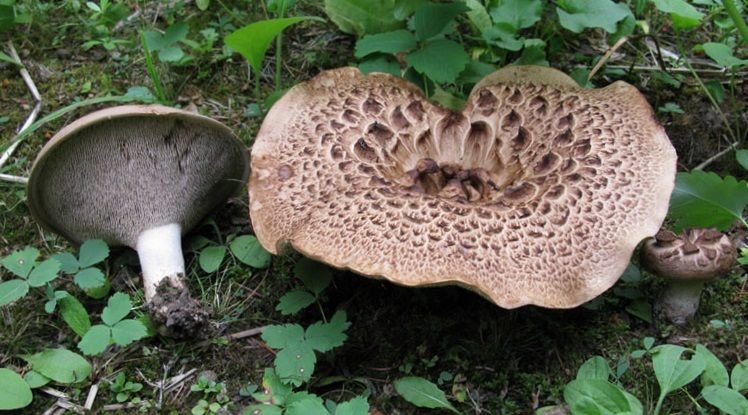
It is believed that the Rough Hericium may be quite widespread in Europe. The fungus is easily recognizable by several characteristic features: a brown to reddish-brown or even purplish-brown cap with scales pressed in the center and diverging as it grows; the greenish leg is much darker towards the base; bitter taste.
Description:
Ecology: Rough Hericium belongs to the group of species, mycorrhizal with coniferous and hard-leaved trees; grows alone or in groups; in summer and autumn.
Hat: 3-10 cm, less often up to 15 cm in diameter; convex, flat-convex, often with an implicit depression in the center. Irregular shape. Dry. In young mushrooms, either hairs or scales are visible on the cap. With age, the scales become well distinguishable, larger and pressed in the center, smaller and lagging - closer to the edge. The color of the cap is from reddish brown to purple brown. The edge of the cap can often be curved, even slightly wavy. In shape, it may resemble an epicycloid.
Hymenophore: descending "spines" (sometimes they are called "teeth") 2-8 mm; pale brown, in young mushrooms with whitish tips, darken with age, become saturated brown.
Leg: 4-10 cm long and 1-2.5 cm thick. Dry, no ring. The base of the leg is often deep underground; when collecting the mushroom, it is advisable to take out the entire leg: it will help you easily distinguish the rough hedgehog from the variegated one. The fact is that the stalk of the rough hedgehog near the cap is smooth (when the “spines” end) and rather light, pale pale brown. The further from the cap, the darker the color of the leg, in addition to brown, green, blue-green and even bluish-black color appears at the very base of the leg.
Flesh: soft. The colors are different: almost white, whitish-pinkish in the cap; and in the leg from gray to black or greenish, greenish-black at the bottom of the leg.
Smell: mild powdery or odorless.
Taste: bitter, sometimes not immediately apparent.
Spore powder: brown.

Similarity: Rough herd's mane can only be confused with similar species of herpes man's.It is especially similar to the speckled Hericium (Sarcodon Imbricatus), in which the pulp, although slightly bitter, but this bitterness completely disappears after boiling, and the speckled Herculean is a little larger than the coarse one.
Edible: Unlike the speckled hedgehog, this mushroom is considered inedible due to its bitter taste.

